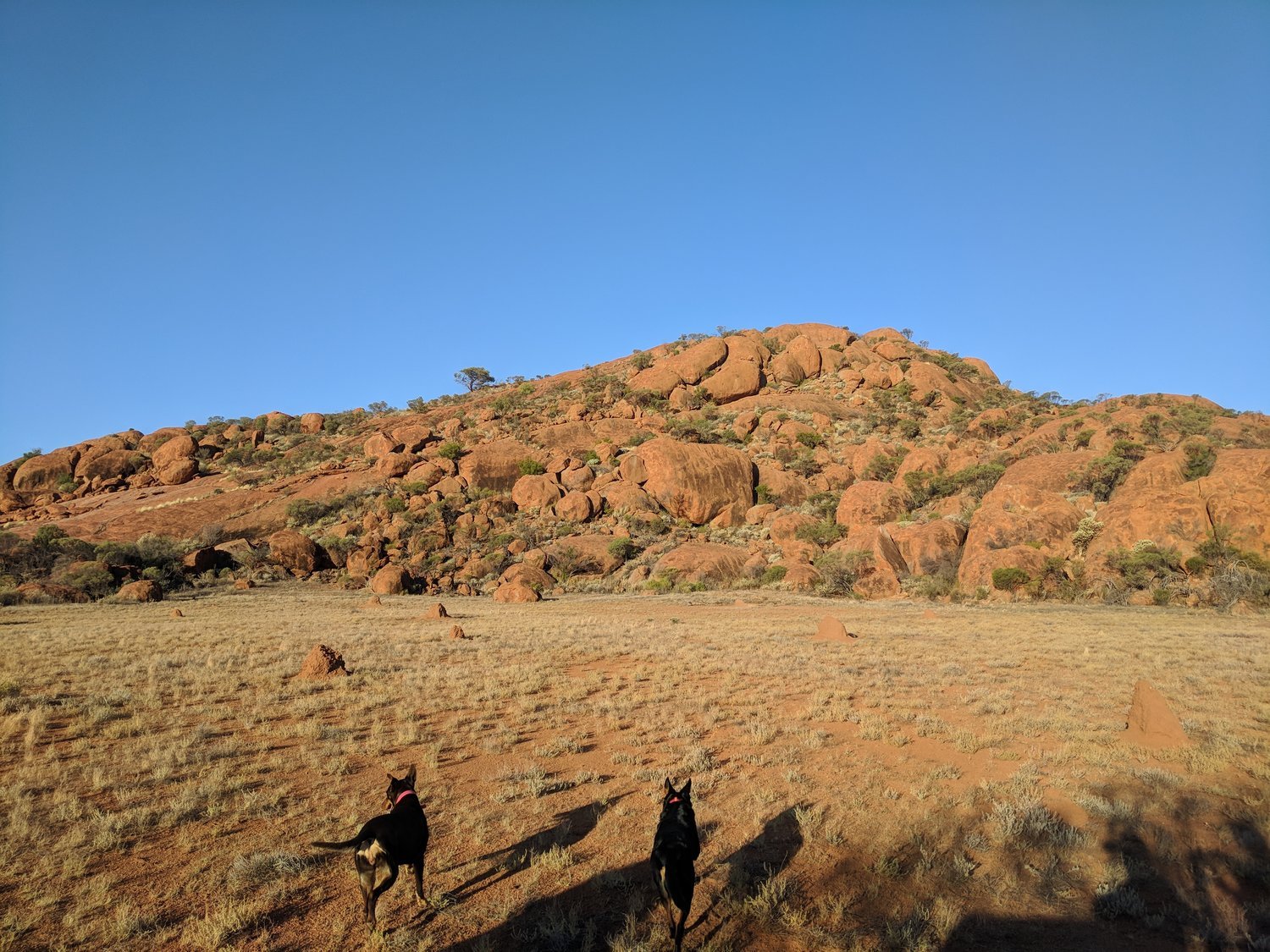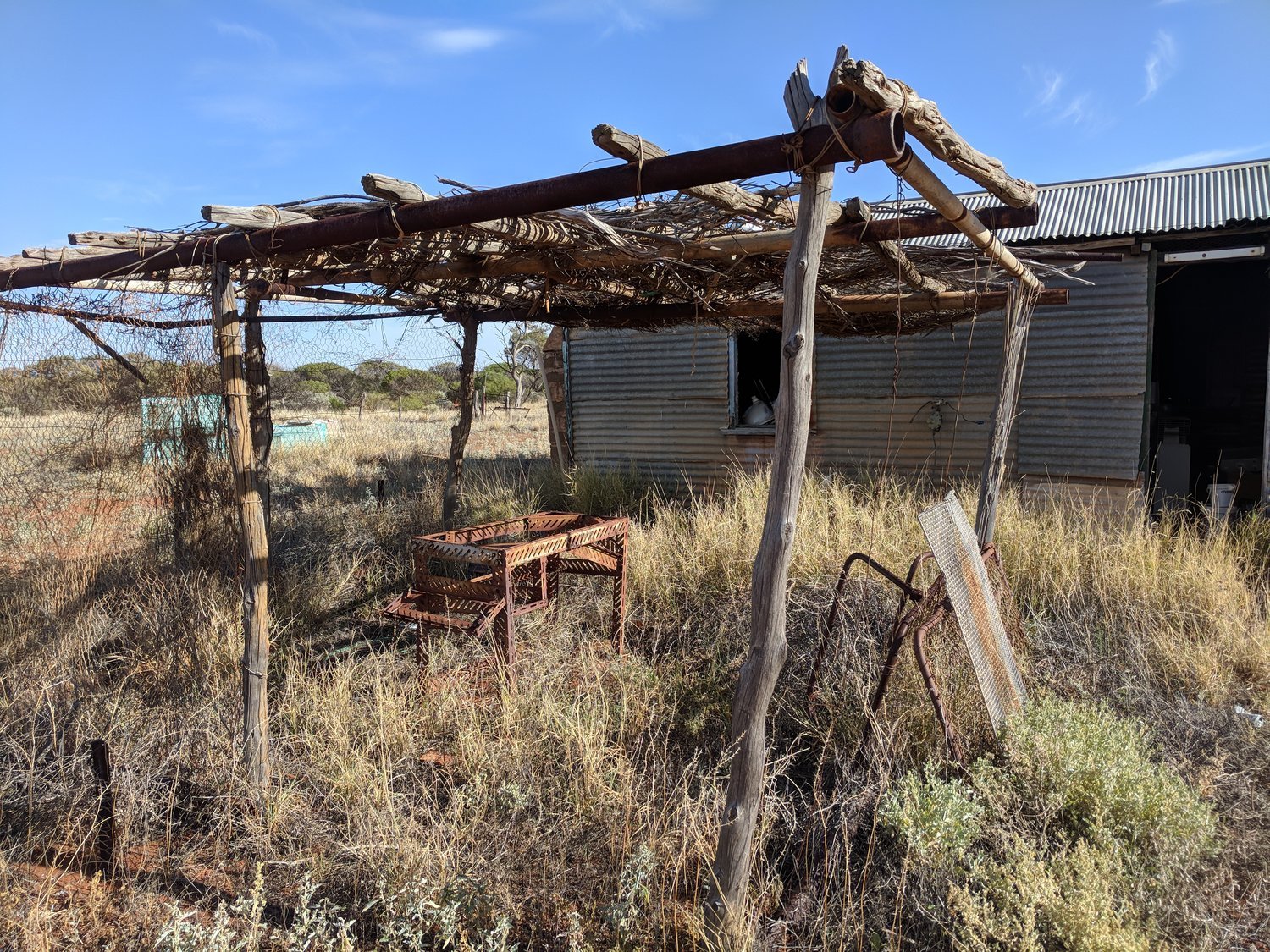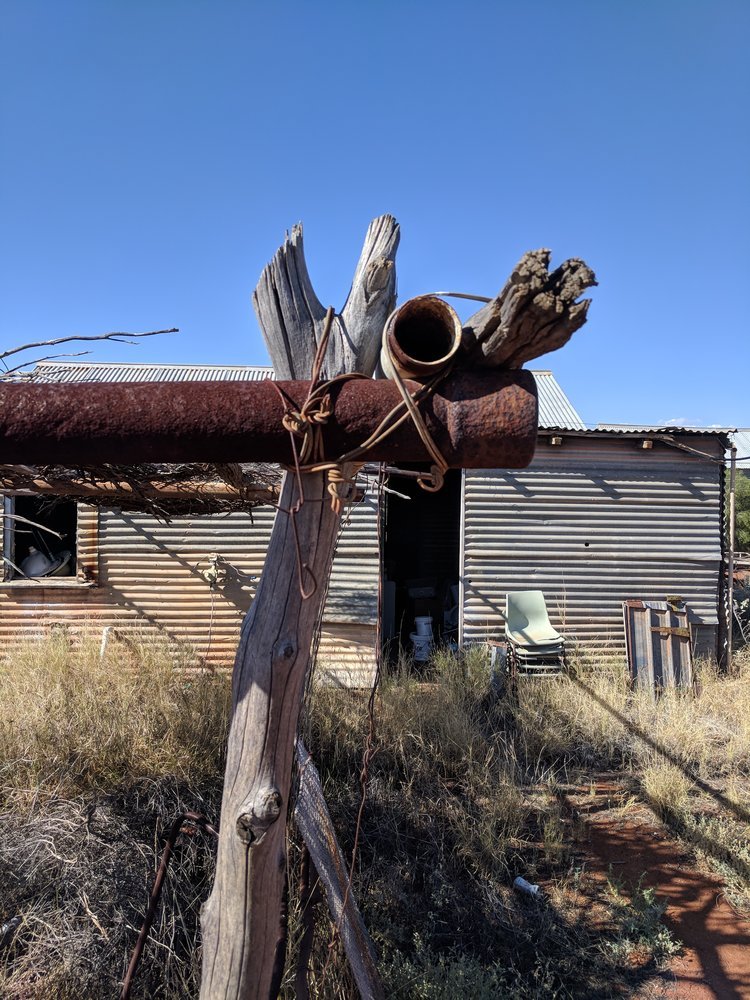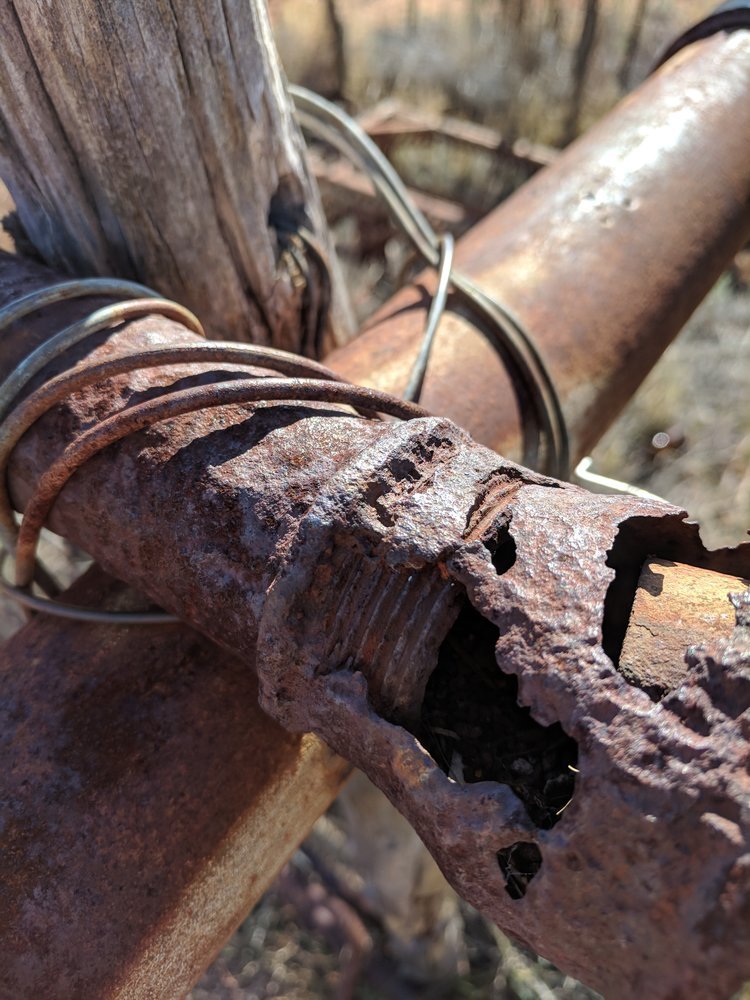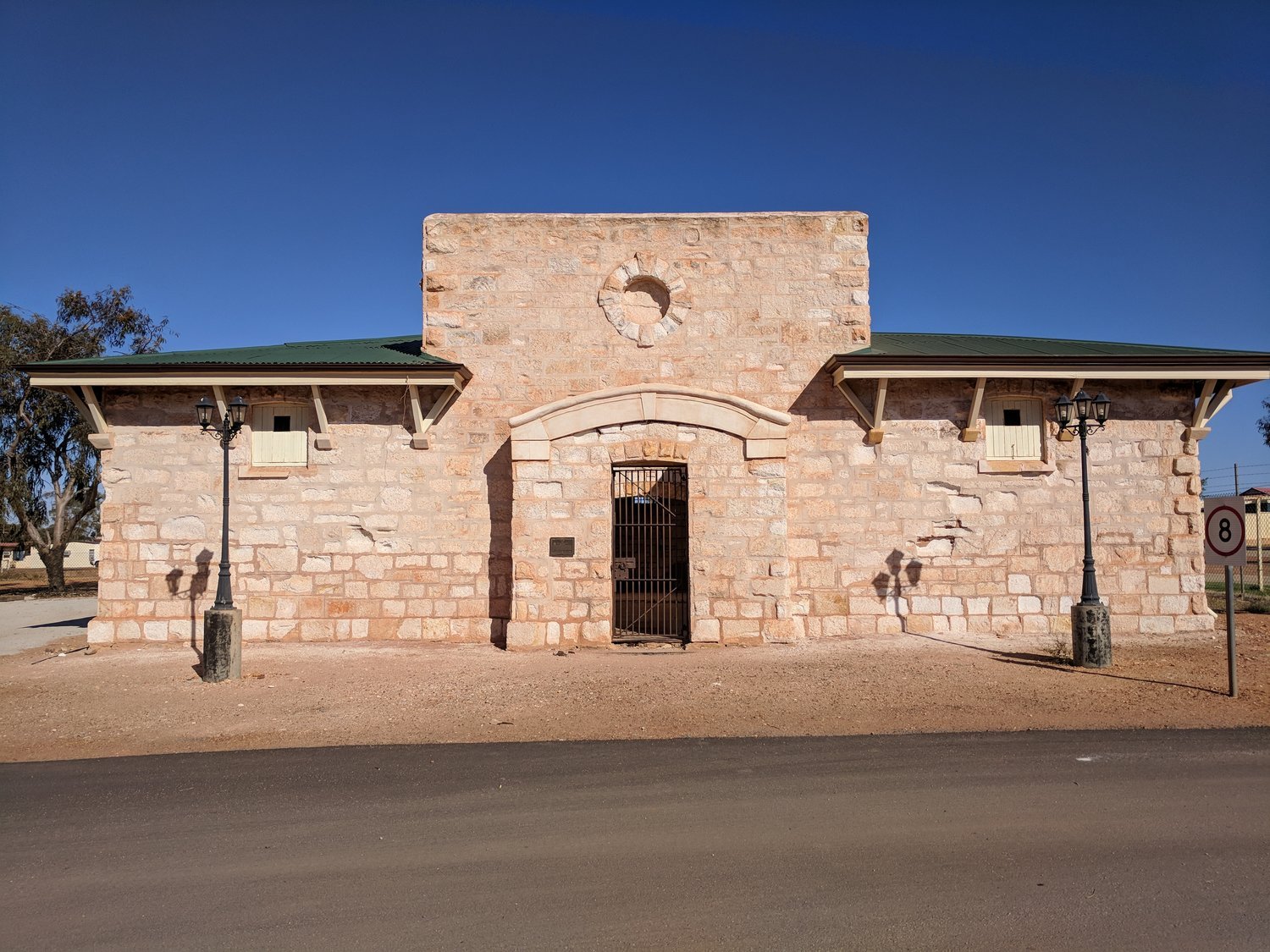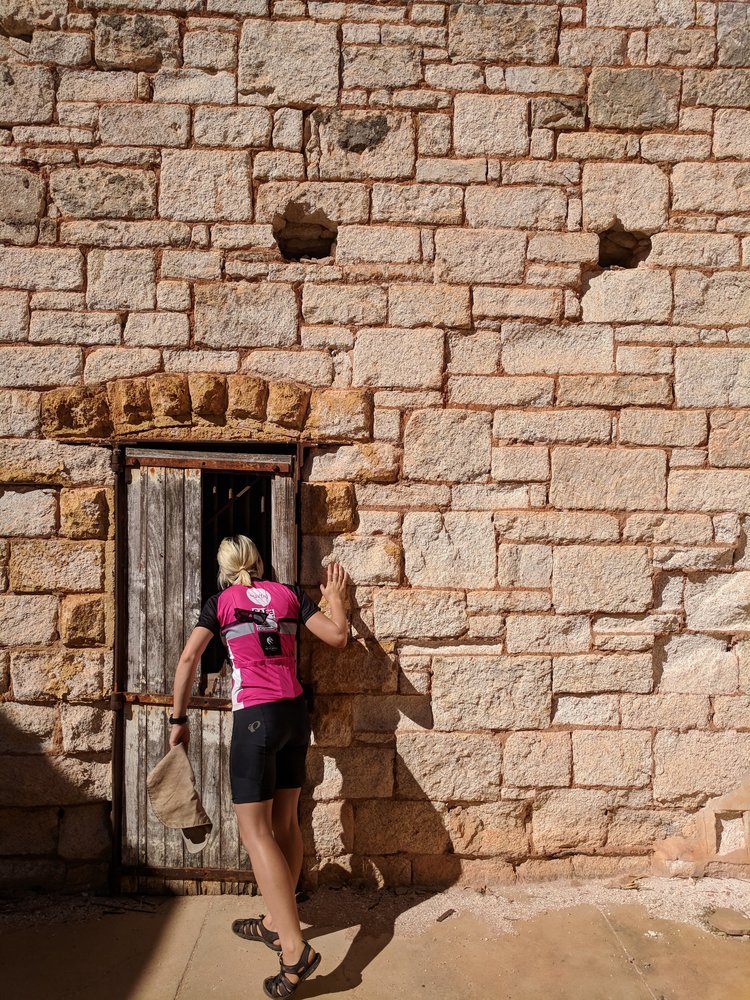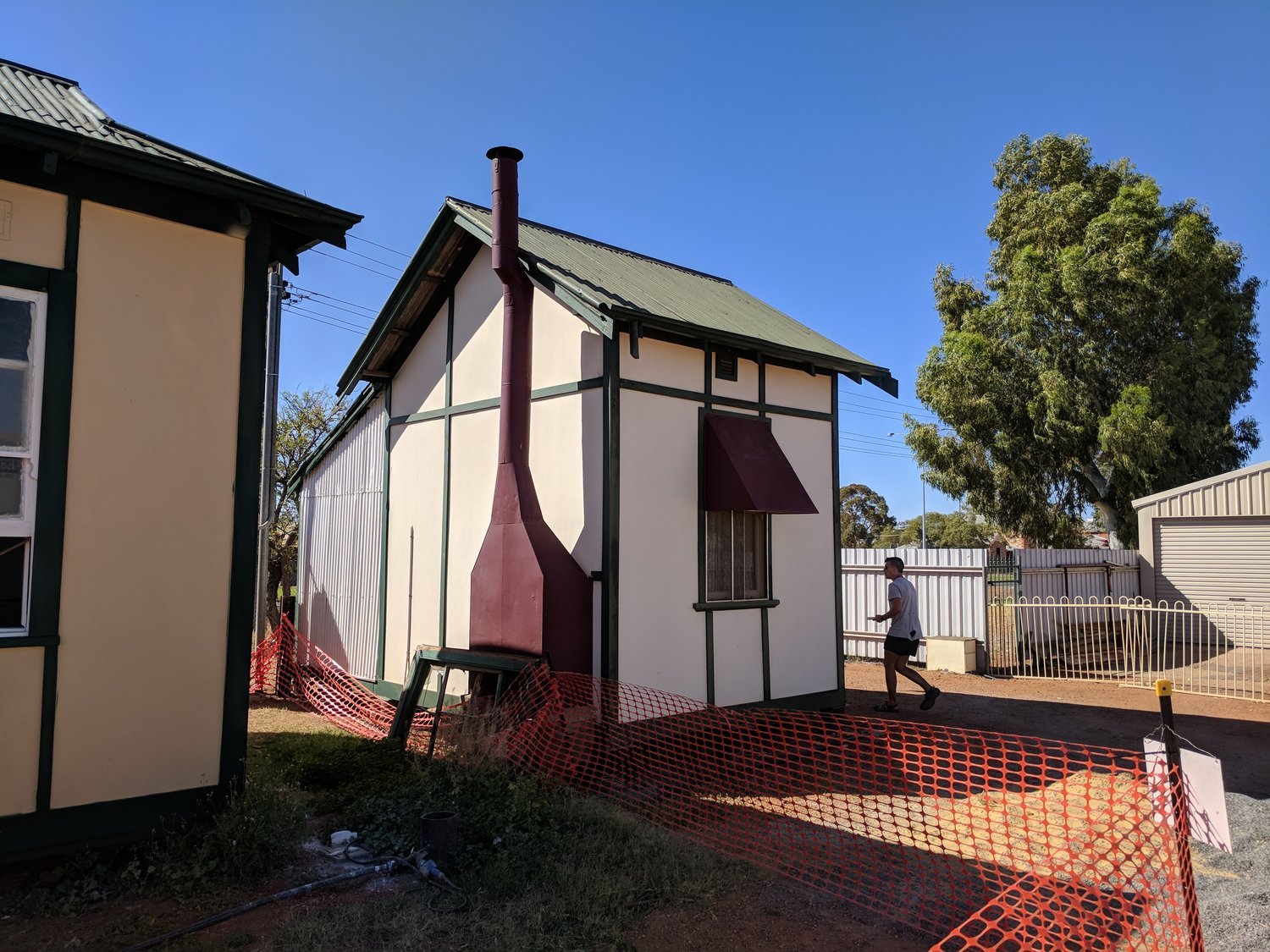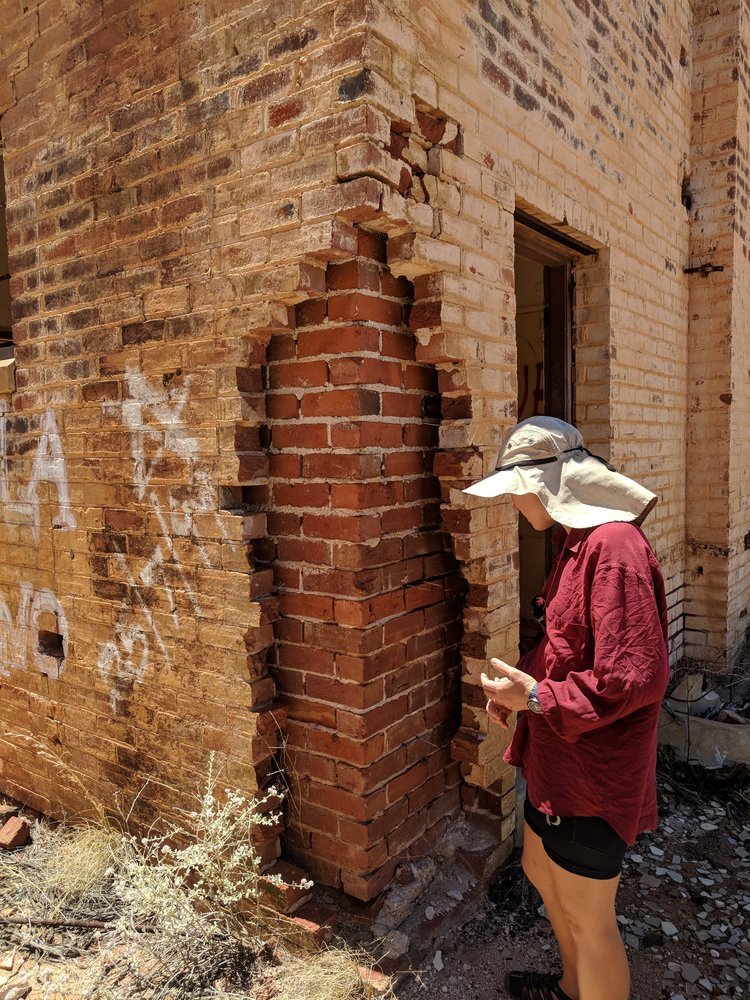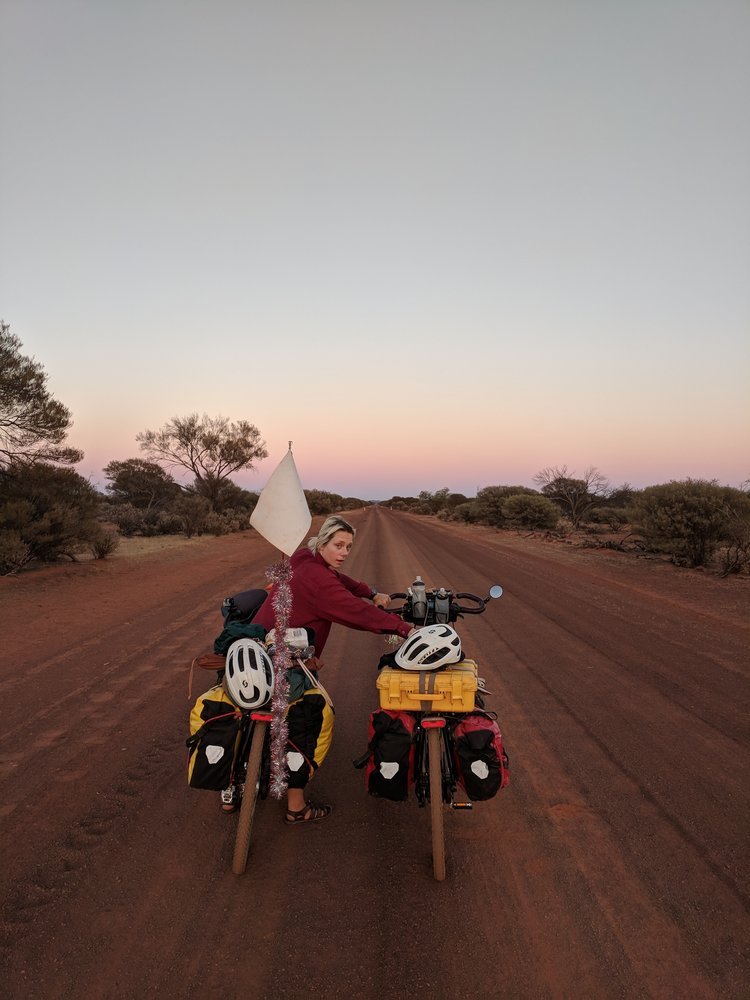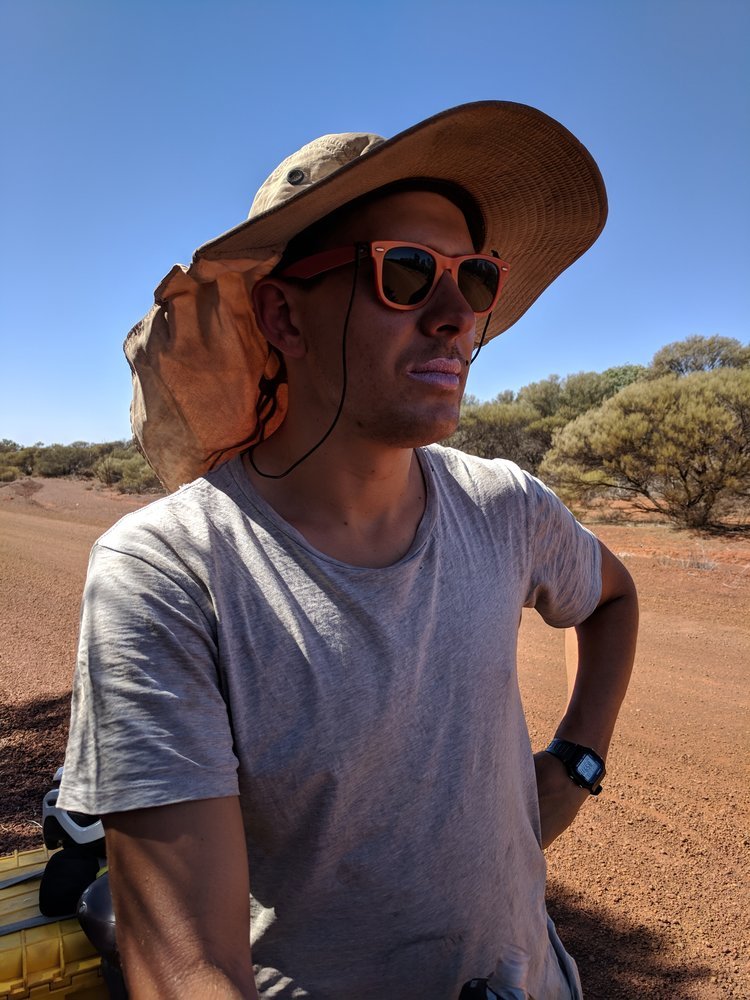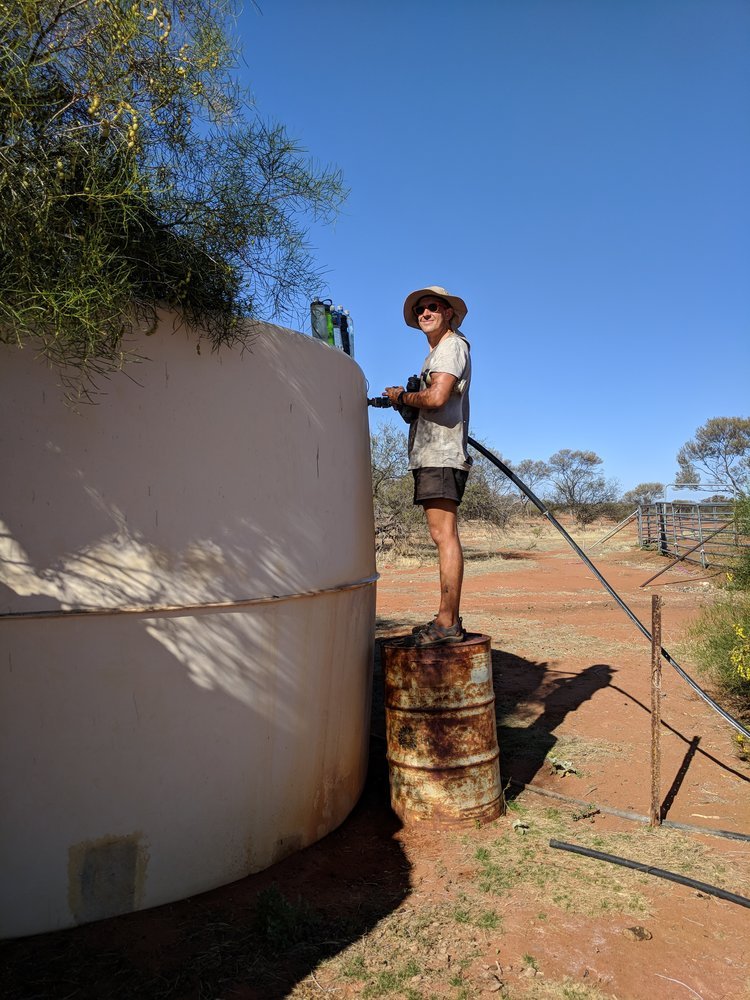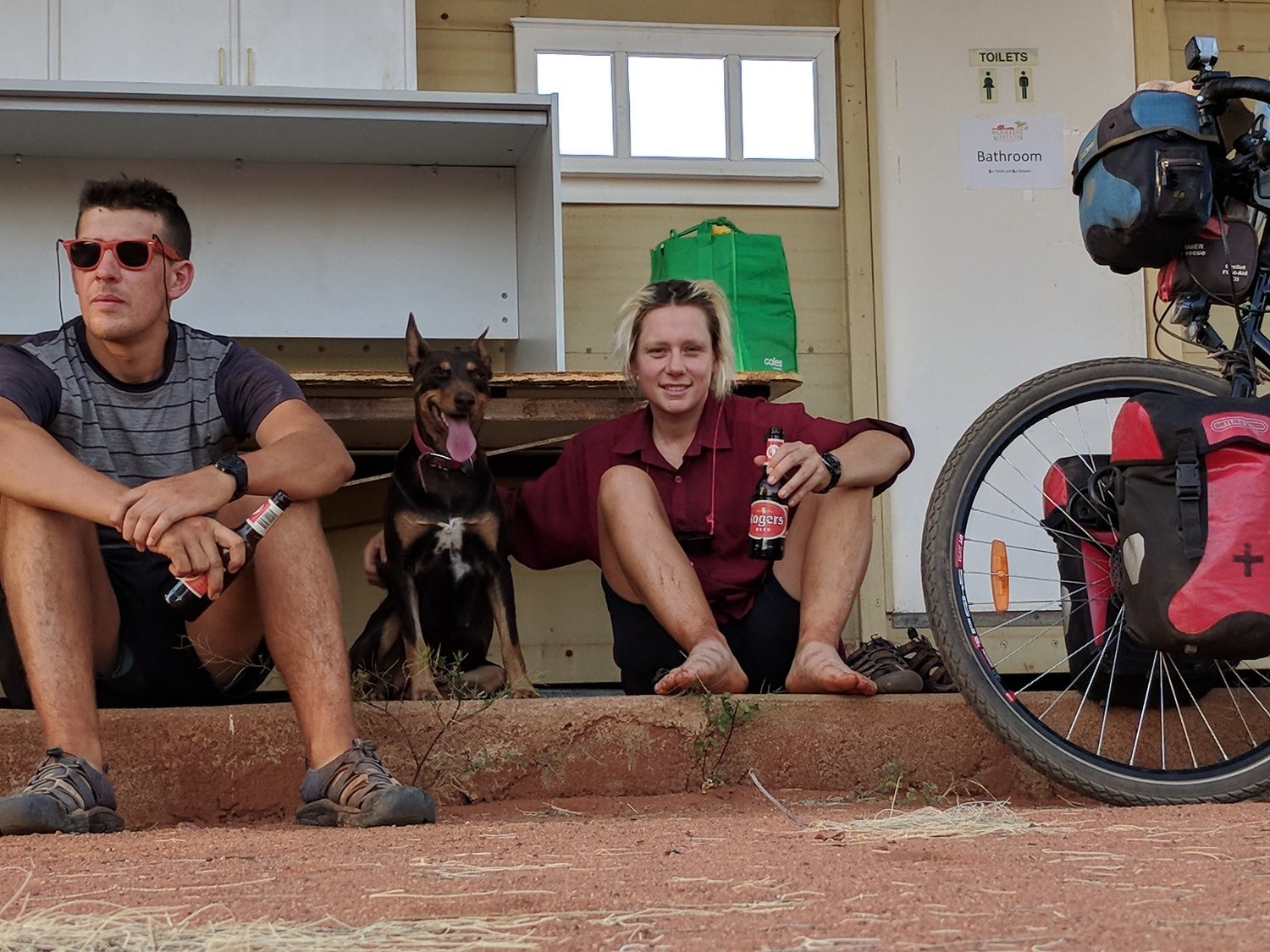The Grand Section Guardian #018 - Stop 18 Wooleen/December 2, 2017
Towering Palms and Gums, like so many other sites throughout the trip are the markers of (white fella) inhabitation both past and present. Pushing through days of 40 degree heat, and a persistent hot headwind, the ‘markers’ gave us a goal to pedal for. What we would come to find is brave, bold, a bit stupid and completely inspiring. A cattle property without any cattle.
Place
2nd-10th November 15, 2017
The ride into Wooleen was some of the most brutal country we have seen yet, even to our untrained eyes. Denuded of grasses and undergrowth, the Mulga scrub battles to find water and hold onto red topsoil which blows in Willy willies across the road. This is Western Australia’s pastoral country, which is why the land looks so robbed. 75 years of mismanagement has contributed to a landscape that is clutching for air [i]. This is the backstory of Wooleen.
Still in the geological area of the Yilgarn Craton this is some of the oldest country in the world. Over 3.6 Billion years old (I don’t know if you can understand that length of time because we definitely can’t). Granite outcrops that once would have easily rivalled Uluru in size are now some of the only significant landmarks that sit above the horizon line. Mammoth in scale against the flat (er) horizon. Places of great importance to black, white, scaled, furred and feathered beings alike. Cracks and crevices trap and hold water, saving lives and providing shelter for thousands of years gone by.
Budara, an ancient, sacred and life saving place. Indigenous Mobs guided early whitefellas here, leading them to water and saving their lives.
Wooleen’s story starts around the turn of the 20th century. Pastoral land was snapped up on Commonwealth Leases throughout the region and the name of the game was wool. Thousands of sheep were brought in and at one stage Wooleen (now 380,000 acres) had 30,000 sheep.
The homestead was built in 1918 and would have cost over a million in today’s dollars, that’s a lot of sheep and clearly profitable! However the land couldn’t support the intense grazing it was subject to and this really began to show after a severe drought in the late 1930’s. The land continued to get flogged, and hasn’t had a break since. From there, pastoralism began to get a lot tougher. They say the problem is rooted in the archaic terms surrounding WA Government's land tenure. Working from outdated legislation, it fails to address modern-day pastoralism to allow diversification beyond stock grazing to rest and regenerate the land like Wooleen. This seems to be an ongoing problem we've faced, the rift between policy and reality.
We asked the difference between a farmer and a pastoralist, the answer; “farmers have money”.
Many pastoralists are realizing that they HAVE to diversify to make ends meet. Many stations have turned to road maintenance contracting for local councils, FIFO mining, boring, earthworks, etc. This is a direct result of the land not being healthy enough to sustain cattle or sheep. Wooleen, has turned to tourism and they said anyone else would be stupid to try what they are.
Today Wooleen is part of a small handful of radical forward thinking activists. Not in the long hair, hippy sort of way but, of the Acubra wearing, motor bike riding, cattle loving sort, where the landscape is the priority. Wooleen is a cattle property without the cows, in a bid to rehabilitate the land and improve pasture to have a serious go at sustainable pastoralism. Something we agree is needed for our future. Being at Wooleen, the problem becomes real and tangible, discerning even. Driving around the property with the two on errands, they would point out and explain of ancient Mulga's and Gidgee's 800 odd year old, predating white settlement 4 fold! They allowed us to 'see' and from that we did notice the huge generational differences in vegetation and the lacking under story, signs of an unhealthy place.
Early white explorers talk about the native grasses up to the bellies of their horses and of large groups of aboriginals harvesting native millet for threshing. This wasn’t pastoral land, this was agriculture!! However we couldn’t find the reference for this so if you have any tips, holla at us!
David and Frances are using several techniques to attempt to improve the land. “enviro-rolls” or to us more simple folks, giant rolls of re-enforcing mesh, are placed in creek beds (with the help of school kids) which catch sediment, branches and other objects floating down rivers. The aim of this is to slow down and spread water allowing topsoil to remain in place, the landscape to absorb more moisture and native grasses a better chance to grow. Attempting to stop erosion in creek beds, David and Frances are also building ponding banks which act as temporary dams in creeks, slowing water and stopping sediment which is given a chance to settle and repair eroded gullies and creek beds. Irrigated seed nurseries section off tilled and seeded land to allow native grasses to germinate and establish themselves, and the most controversial is their opposition to the baiting of Dingoes. Much to many neighbours disagreeing, they have allowed them back on to the property. Being territorial in nature, dingoes establish a familial hierarchy which monitors breeding and their territory, this has been the answer to the decades of devastating wild goat and kangaroo populations which have now disappeared. Dingo's don't pose a threat to cattle belonging to a healthy place.
To see if this is working Frances and David are keeping their eyes peeled for plants and trees as markers of progress. The massive re-growth of native grasses on the Wooleen Lake and the spread of tea-tree and saltbush around its edges are symbolic of this. Their struggles were made worthwhile when the nationally important Wooleen Lake actually ran clear of eroded sediment from the Roderick River in 2009 for the first time in white fella living memory. The broader impacts of this is that, sediment and soil is able to remain where it should be as a result of increased plant growth stabilising the ground plane, healthier land and hence habitats.
Wooleen lake, all the grass you can see is largely a result of the radical actions taken by David and Frances. The sticks you can see ahead of Bobbie were put in place to hold up fairy lights for David and Fraces' wedding!! What a place!
WOOLEEN UPDATE:
After long periods of destocking over the last 10 years, on the 18th of November 2017, Wooleen station welcomed a few cows back onto the property. Whilst we were there, Frances and David were talking about the balancing act of conservation and pastoralism. If they give the land the time it needs to recover there may not be cows on there for 50+ years, whilst this would be the best way for conservation it leaves them alienated from the pastoral industry. Already on the fringes of the staunchly traditional pastoralist, Frances and David need to show that being environmentally sustainable leads to economic sustainability. A tough rope to walk. Good luck!
People
The place is seriously harsh, with almost no permanent water. We take our hats off to the Wajarri Mob who have lived in this area for thousands of years. We read groups of aboriginals would be almost constantly on the move in order to survive this climate. The constant search for water always the task at hand. Gnamma holes, caves soaks and moon soaks (places where water can be found on a full moon) were the go to, life ensuring, party spots.
It was only this year that the Wajarri were finally awarded consent determination for their native title claim over the country they have managed for generations, a 20 odd year struggle. Meant to be a happy day, we were told sadness pervaded because over a 20 year long fight, age and death met many of the elders first. Wooleen is known to this mob as Bardiyarra “good place”, a feeling shared by the current mob on the station. The current mob being, Dave & Frances where together they make quite the team.
Dave Pollock
It wasn’t till several nights in that we met David, whose sharp cattle wit cuts through bullshit and seriousness alike when not getting fantastically and childishly excited by new shoots of native grasses.
David inside the irrigated seed nursery, directly after screaming in what could be described as childish delight at finding a native perrenial "Ribbon Grass" seedling. The first one on the property....
David pegged his relationships with family, financial future and stress levels on the line when taking over management of the family lease just over 10 years ago. Dave was the one who took the bold steps to begin de-stocking the land and start the rehabilitation process, at 27.
With his father taking up the lease when Dave was a young boy, the red dust of Wooleen is well and truly in his veins. He talks of the landscape intimately, like a sibling – he knows it well. He talks of certain (rare perennial) grasses and trees and knows exactly how many have even been over the entire 380,000 acres over his lifetime. He has cupboards of maps which he often refers, knowing the landscape at all scales, and he knows the value of the place. An inspiration to talk to, the man had clearly been thinking about every question asked for a very long time. In the midst of writing a book about it all, he claims it’s about making people aware of the issues of the pastoral industry and lease agreements, because if he doesn’t, the broader audience will never know.
Frances Jones
As we push our bikes into the shade of the gums and palms that surround the homestead, the dust from the road settles as it gets caught in the vegetation and we are intercepted by a warm, instantly welcoming laugh with “Oh, you’re early!” Frances invites us in like old friends, effortlessly making us feel comfortable.
Frances arrived on the scene 10 years ago and has really been the lynch pin that has allowed Wooleen to continue whilst other attempts at rehabilitation on different properties fail. Frances is the perfect host, which is bloody lucky since Wooleen’s main game is now, tourism. Unlike the tourism we have seen in other parts of Australia which has sucked personality, local agency and long term inhabitation from a place, tourism here, has allowed David and Frances the breathing space they need to give the land room to breathe. Frances eloquently worded this as being able to invest in the place, because it keeps them present.
Frances and Owen climbing out of a cave on Budara. Owen is thinking that he should have thought about how to get out before moving.
And although the tourism thing was something Dave’s family also had done well and truly before Frances, you can feel and see her touch on the place. Her mind stretches over every detail, leaving a holistic-ness to the experience. Frances’ background is in environmental tourism and marketing which she has had to squeeze to the nth degree to stop Wooleen going under. Only in the last few years do they feel like things are starting to straighten up from the roller coaster of a cow property with no cows.
The crew! Owen is wearing his best shirt.
Stuff (Architecture)
There is very little research on the indigenous architecture of the area. Talking to David whose family have had a decade’s long and productive relationship with the local mob reckons that they wouldn’t have had much. Mulga humpies would have provided shade and there is significant evidence of cave use in the area. The granite boulder heaps, a significant and important formation called “Budara” has places where the rock ceiling has been scalloped out due to innumerable fires. Ancient campsites. Caves provide cool shelters using the gigantic mass of millennia old stone formations. Digging down in some, permanent water resides.
A more contemporary take on the Aboriginal shelters are the fantastic bough shades, made from whatever is at hand these brush stick shelters are basically like sitting under a really good tree. They still adorn the old Indigenous quarters on Wooleen and David tells us some of the local mob always tell him to make sure not to knock those houses down.
The settler architecture of Wooleen is emblematic of another time, when the place supported vibrant life. A healthy place supporting a healthy architecture. Sprawling over the homestead site lies a conglomeration of buildings.
Photo of Wooleen Homestead from The Vagabond Life Insta, click on the picture to see more of their epic pics. Note the homestead vegetation.
The most exciting structure for us was the incredible vaulted corrugated iron roofs by pre-world war two builder, Alf Couch. Built by curving corrugated iron two ways to form an “S” shape, placed on either side of the space to be vaulted then riveted together with curved central piece to form a structure free space. Alf takes this to a whole new level with the Wooleen shearing shed mess which has two intersecting vaults (called the groin)! A bloody cathedral of corrugations! Onya Alf!
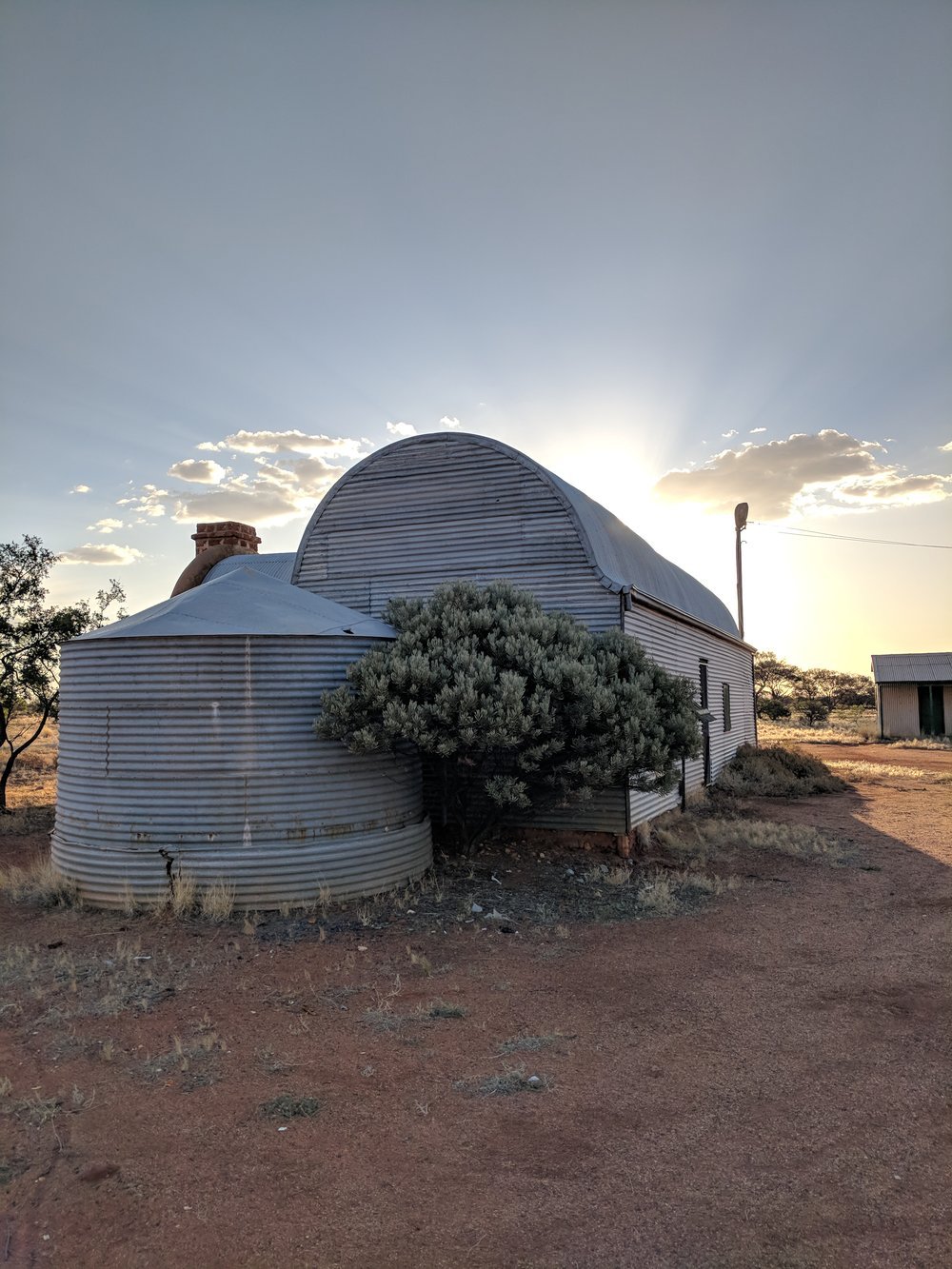
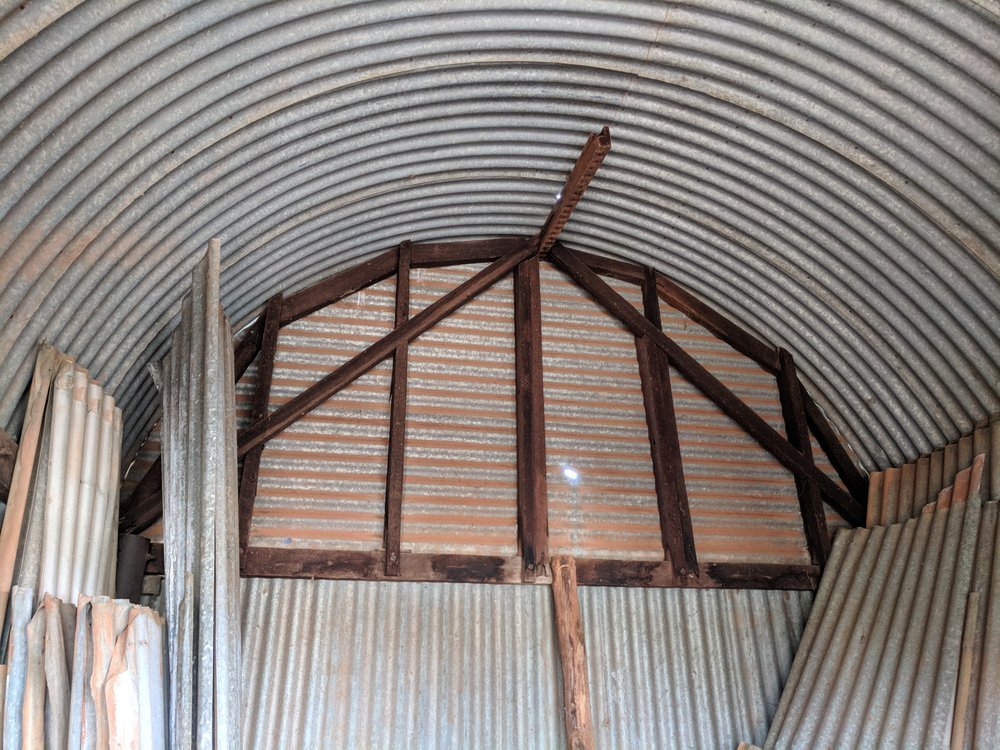
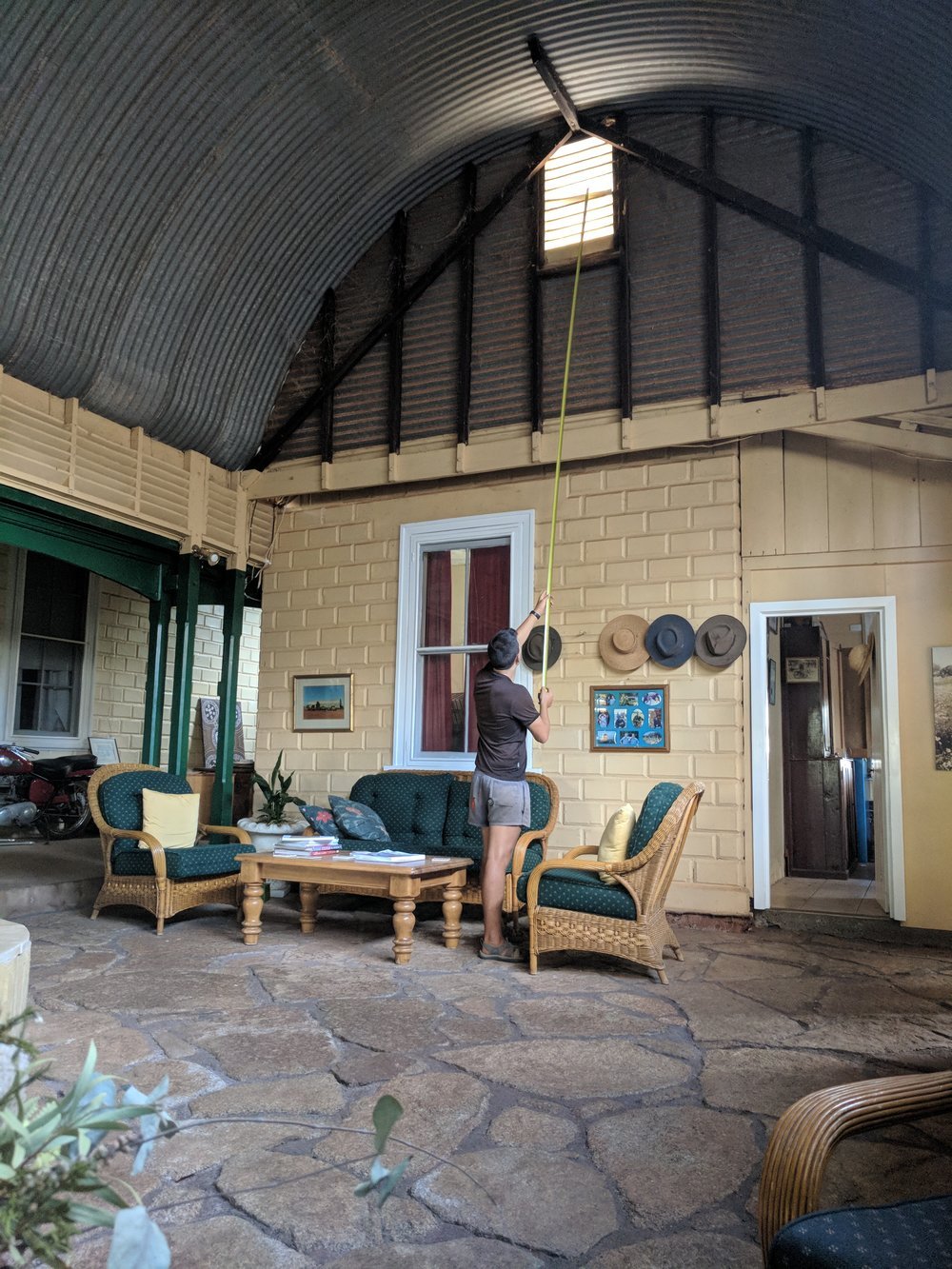
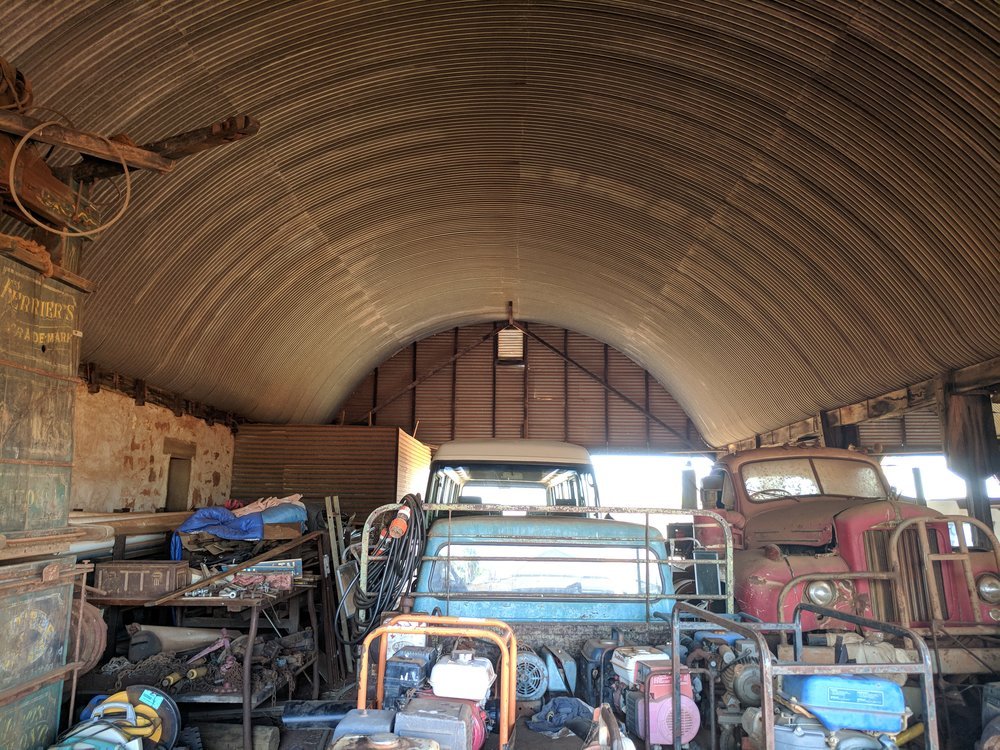
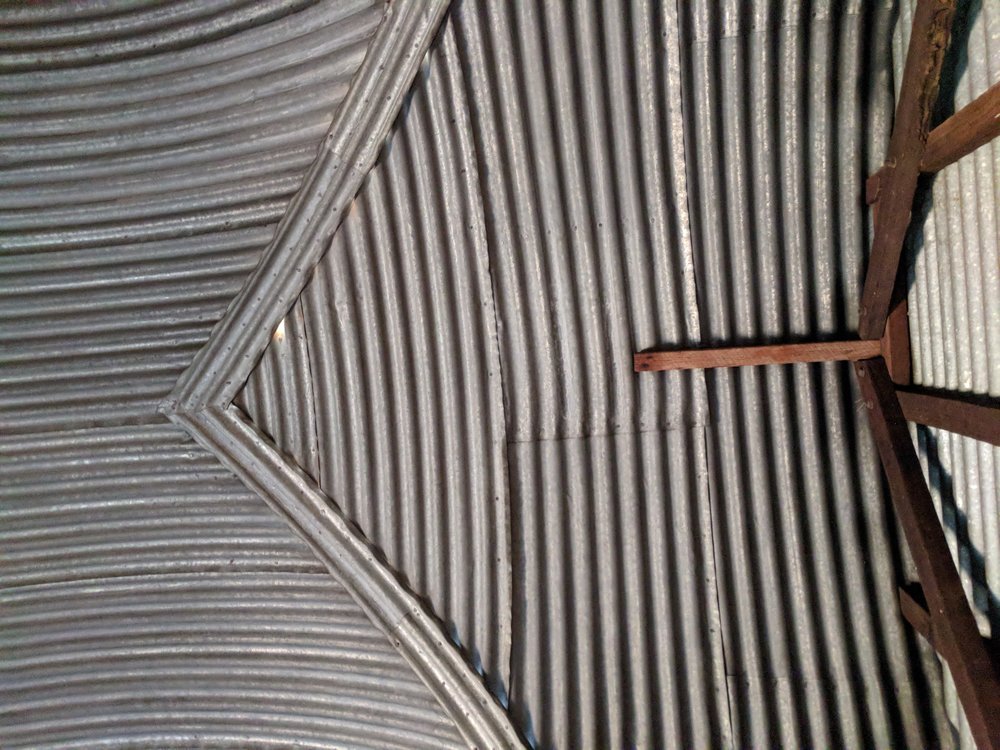
The homestead was built as separate pavilions from bricks made from sand on the property. Grand in scale and planning, this pearl of a building is an earnest attempt at making British architecture work for the hot Australian climate. Verandah’s all around, tall ceilings, ventilated eves, large roof cavities, suspended timber floor and orientated to capture the ‘sea breezes’ help to cool the house to make it livable. However until recently (with the purchase of an evaporative air-con) during the height of summer, David and Frances would sleep outside, on the grass, on shearers beds, just on the edge of the sprinkler in order to stay cool. Regardless, a pretty grouse old building.
Outhouses and service buildings are built in a similar manner with large overhangs, ventilated eves or vaulted ceilings. Guest houses built in 2004 also take lead from the building of the site with large verandahs and ventilated eves however have used locally sourced earth for rammed earth walls. We are not convinced that this is the best option for hot climates (well, how they tend to be constructed with smaller eaves then required) however they were built for tourism, which only operates in the cooler months so maybe they are a good option.
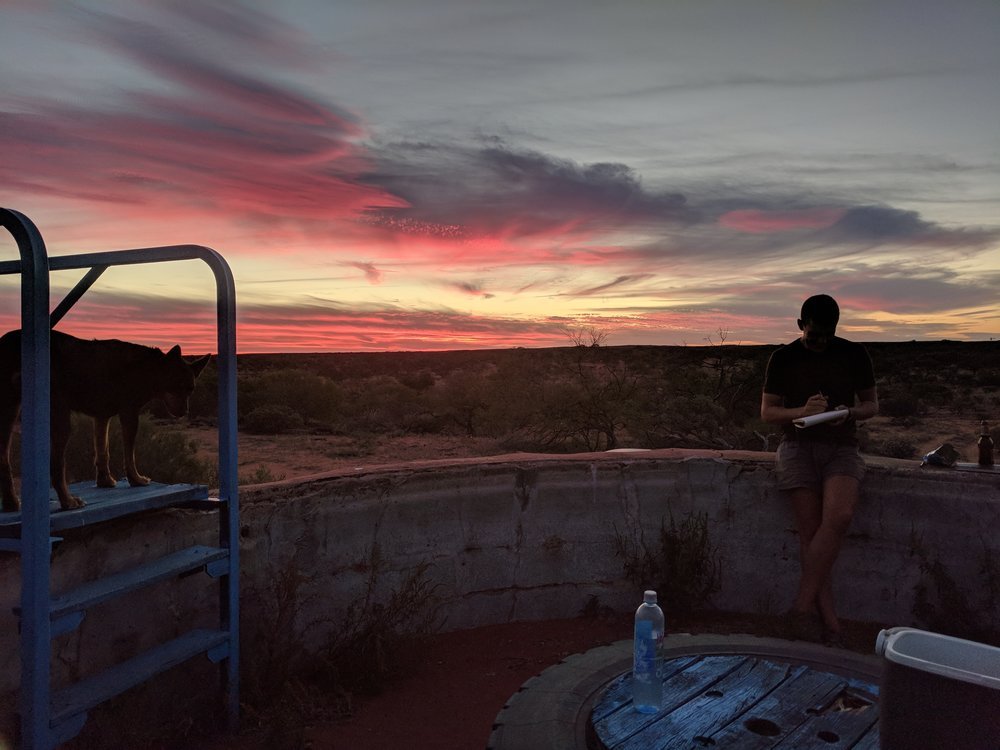
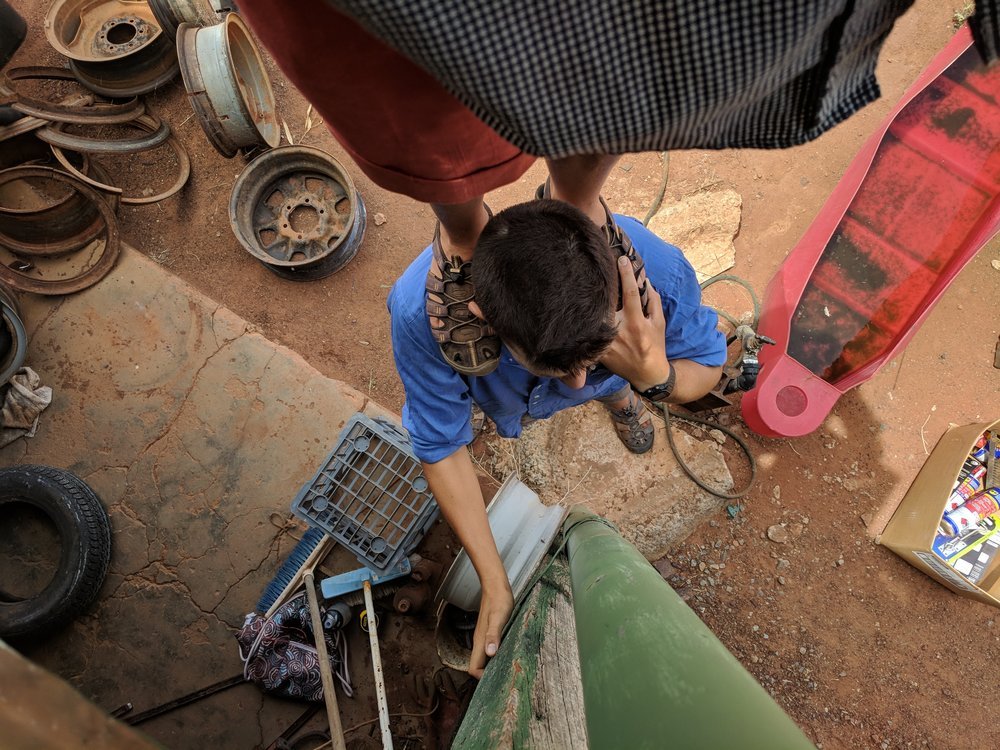

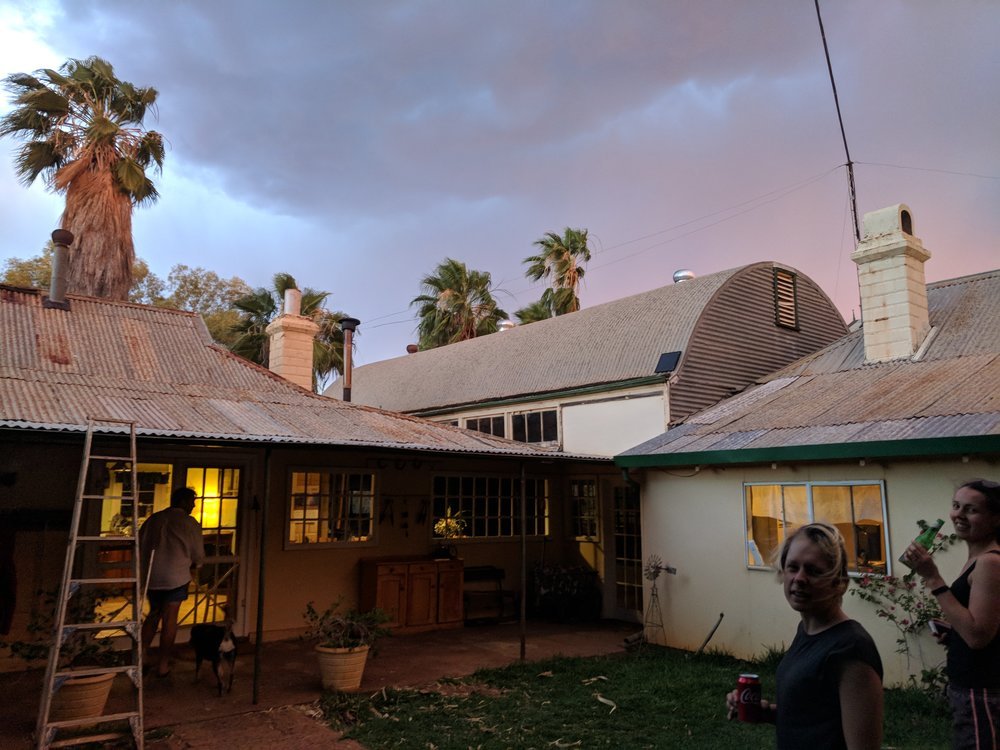
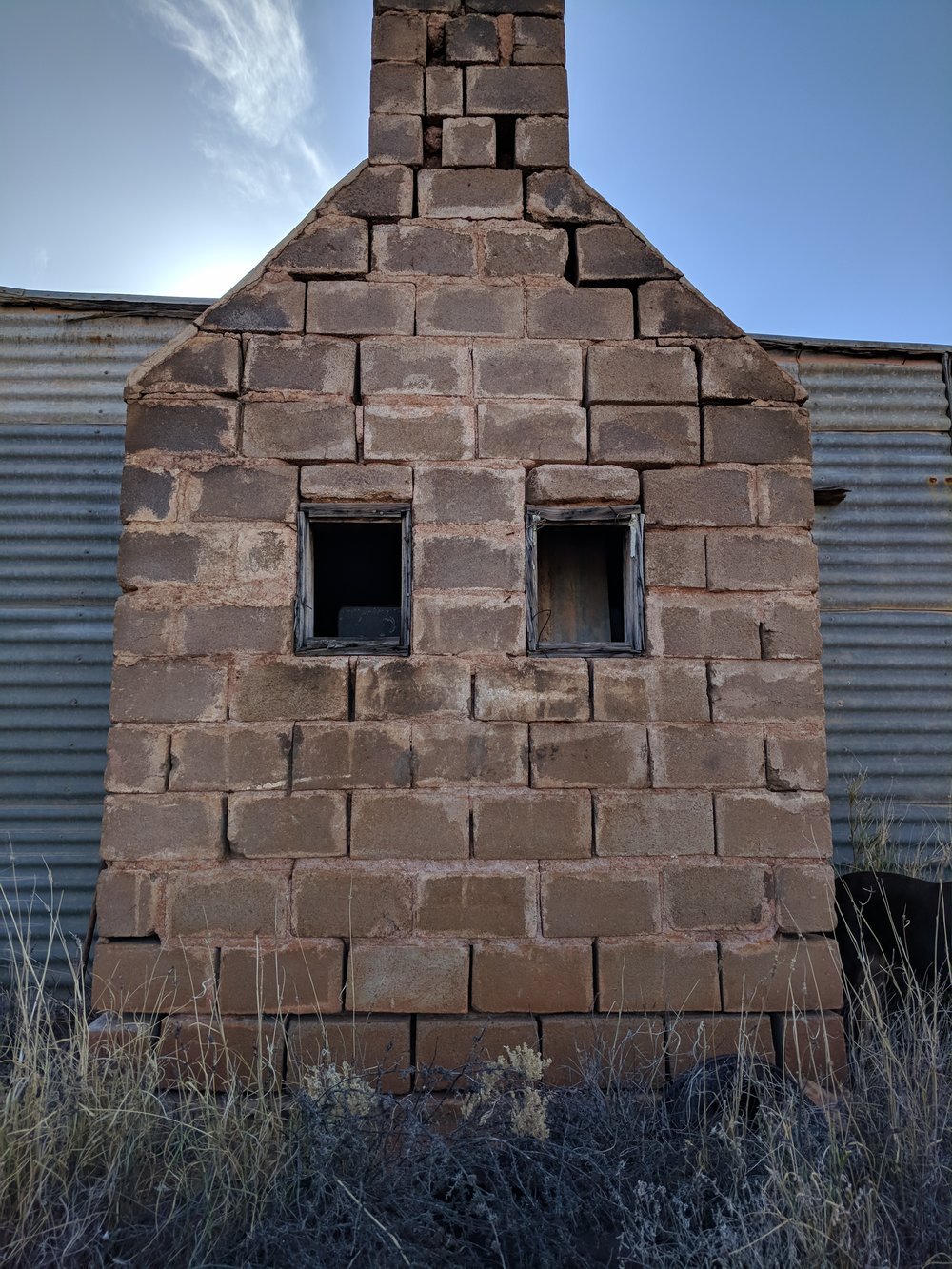
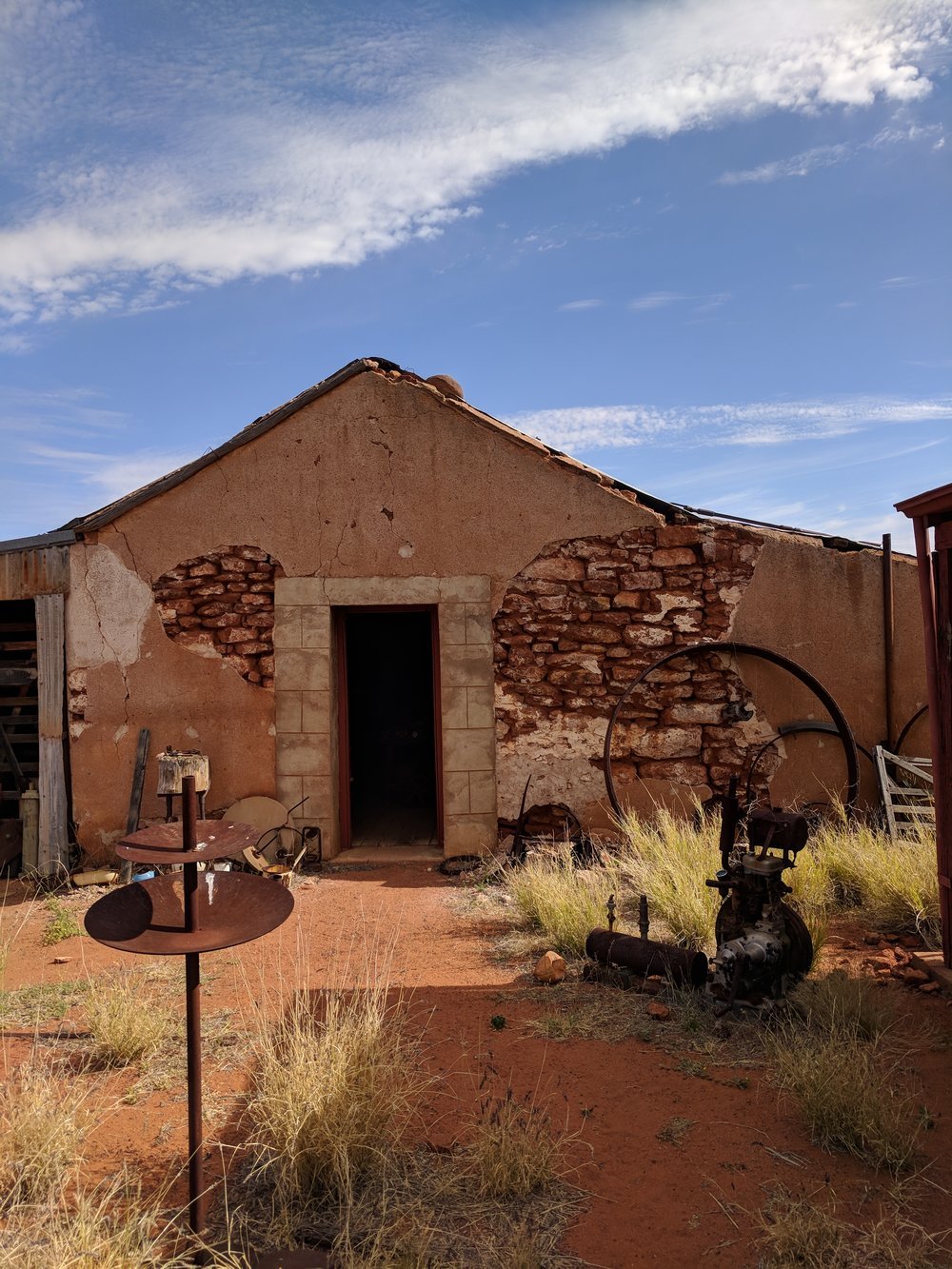
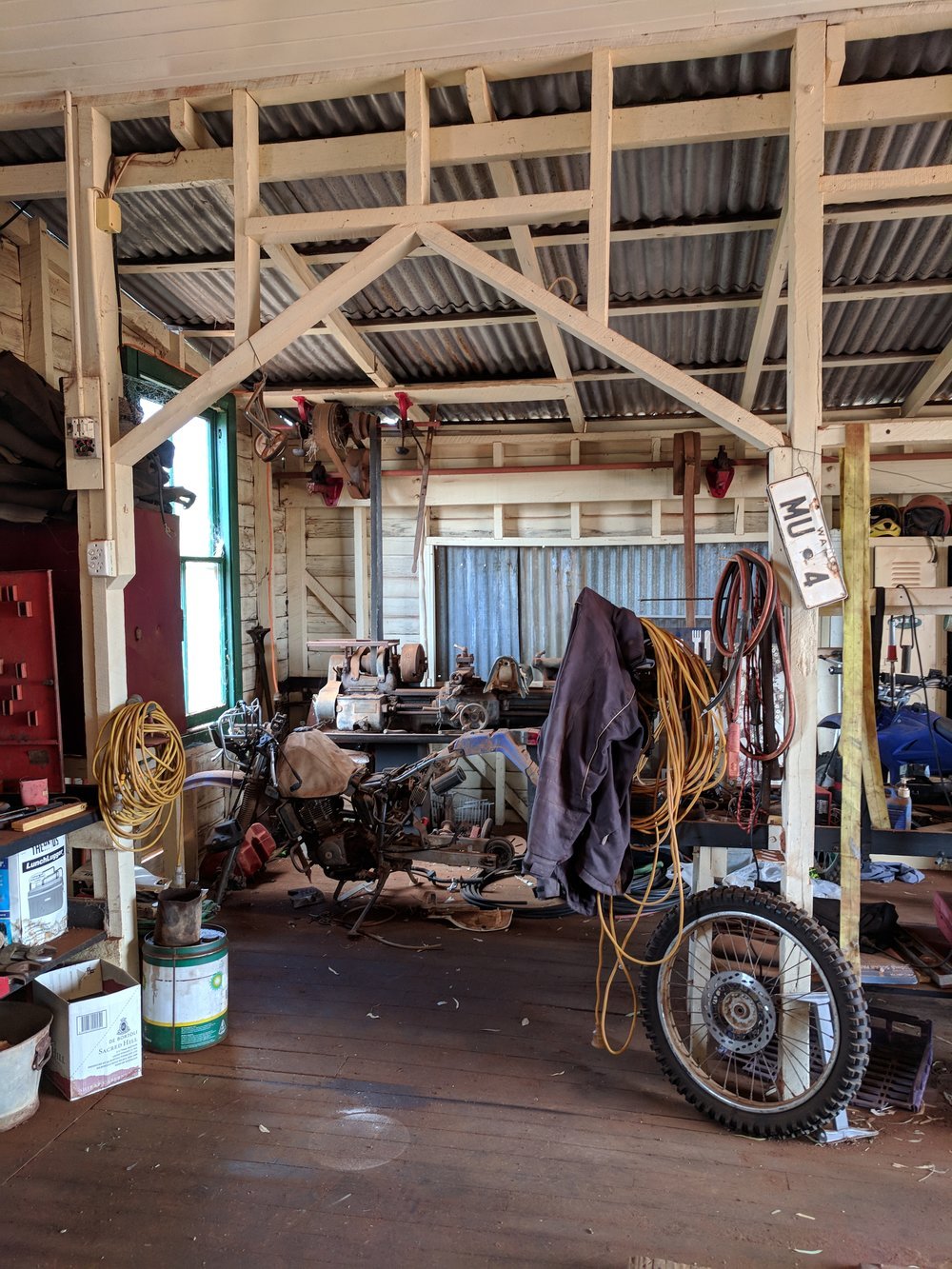
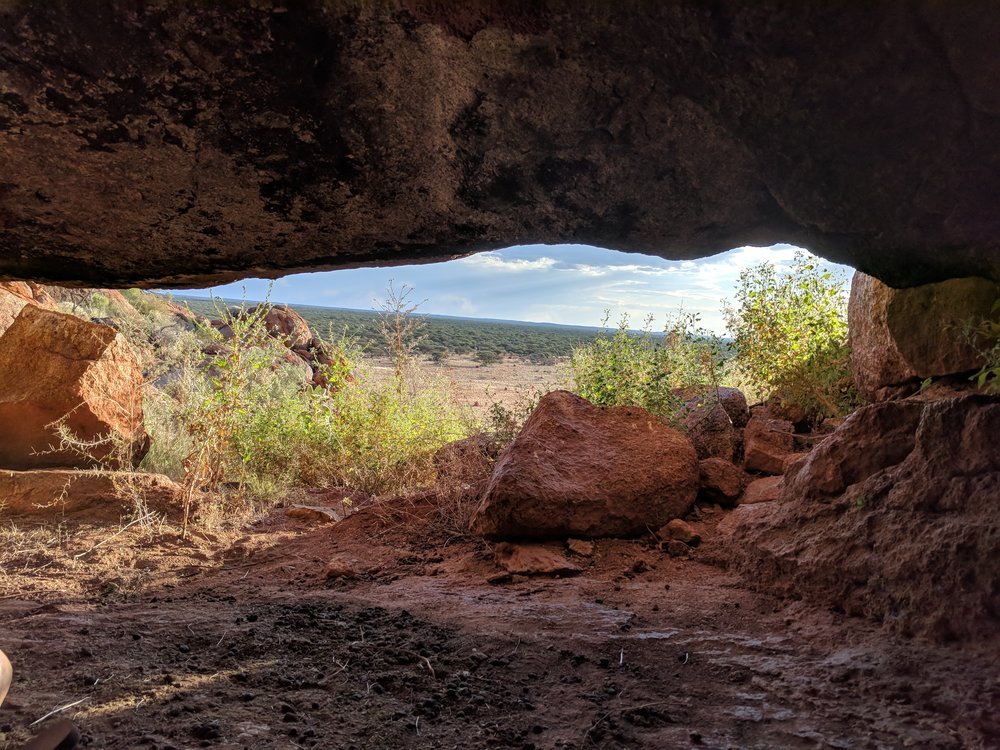
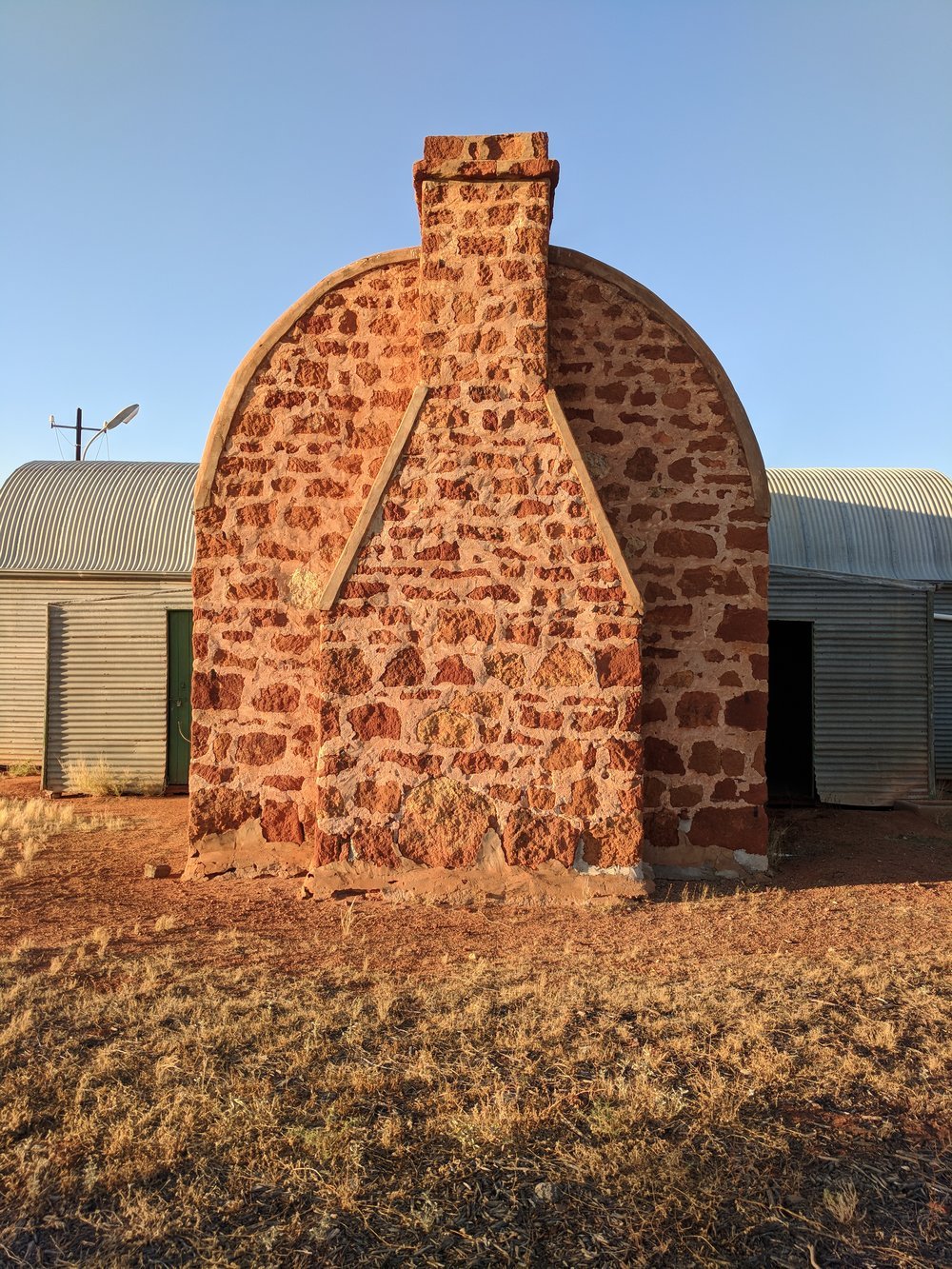
Being one of the only spots for accommodation close to the Murchison radio-astronomy observatory (CSIRO run) Wooleen is frequently asked to house contractors who can stay for months at a time. If put into the homestead accommodation, they take away opportunities for Frances and David to get in touch with their target and on-going market/supporters. So…the ubiquitous donga enters discreetly through the back gate. Without the healthy land this is what is economical and accepted.
Exhibition, we left without finishing it…
With a name like Wooleen we couldn’t help ourselves but create a Wool ZINE!!! A small magazine documenting the architecture of Wooleen, looking at material use, construction details, temperatures, passive cooling techniques and proportions. However, this was the first stop that we couldn’t get our work finished. We had to leave them with an interim zine. Despite our best efforts we just could not summon the energy to keep working through the nights like we have been at each stop prior to enable us to have our ‘exhibitions’ finished & presented. I think this speaks loudly of our fatigue. Although emphasis is on slowness, it doesn’t seem slow enough.
Wooleen Office / Dinner Invite
On top of this the intention is not only a documentation for our own purpose, but Dave & Frances are keen for the Wool ZINE to be material for their guests to enjoy whilst visiting the homestead. Not having any current plans or documentation of the homestead they were excited to finally have something drawn up. We were excited to provide the exchange, even if the work does only get used for a fire escape plan on the back of guest room doors. Regardless, it had to be good. We finally sent them through a printed version of the zine from Denham on the 27th November following stop #19.
The in-between (Wooleen Station to Useless Loop)
10th - 15th November, (6 days)
The day before we parted, Dave received his long awaited Drone. The intention, to document the landscape as it rehabilitates and at the point when cattle are re-introduced he foresees it’ll be hugely beneficial for tracking cattle for mustering rather than his prior technique of tracking on foot. And so, riding out we were fortunate enough to have the duo keen to get some footage of us. The images are beautiful and provide incredible context of the landscapes we’ve been traversing.
Riding out of Wooleen property.
On we rode the 36kms north-west to Murchison into a head wind. Arriving, we realized we were bloody exhausted and so booked in for two nights into the grassed caravan park out back, parked our bikes and went and slept under the shade of a willow tree as the afternoon passed. The following day we caught up on work, including the Wool ZINE and some final tweaks on our up and coming presentation for the national student architecture conference, AGENCY (the movie which premiered in Meekatharra).
Riding on we reached the turn off to Butcher’s Track, the second last westward leg we’ll ride and the last stretch on red earth. A lonely track and sandy. In stretches, the track was cut by black lines, close up, armies of ants coming from and going into seemingly nothing. Further on and absolutely exquisite, the road was covered in what looked like drill holes and flies hovering. In fact, they were a native species of bee, the Dawson’s burrowing bee’, unique to WA’s north-west. Typically found in hard-baked clay bans, they don’t live in hives or produce honey. Instead the female deposits pollen around the egg so the egg can live off it when it hatches. What an incredible adaptation eh?
Early mornings to beat the heat and wind, and long days. The landscape turned quite heavily vegetated, still of a low scale and becoming undulated, what we presumed were the re-appearance of sand dunes. The road sandy at times, too sandy to ride and with each break came a nap if we could find hardly enough shade.
Seven kilometres after lunch, on the second day, we saw caravans, trucks and cars with boats zooming past ahead. No it wasn’t a mirage, we were back to a busy tarred road where the priority is the destination and not much else. We were hit with multiple flat tyres as soon as hitting the tar, BUT it didn’t worry us too much in this scape as ancient trees provided somewhat substantial shade, big enough to even stand! Dead smells returned and a Telstra tower marked The Overlander which became our last point of contact to Useless loop. The next stretch was anticipated to be a hard stretch with wind and road surface.
And so it was, the hilliest terrain we’ve had since The Great Dividing Range on the east coast. On one hill, Bobbie calculated an 800m wide swale with a 200m quick incline to the crest. The landscape continued to change incredibly, Banksias re-appeared which we too hadn’t seen since the east coast (Ashby's Banksia, particular only to this area) , the wind cooled, bleached white shells comprised the road base and the scale of vegetation flattened meaning no shade, and little rest. The anticipation was painful, at every crest we craned our necks to see if the water came into view. At 23 kms west of the Overlander Roadhouse, we got our first glimpse of the ocean. What a moment. For that instant we felt as though the whole trip was condensed down to a tangible, understandable scale, condensing in the back of your mind, rolling into understanding momentarily, before slipping again into the ether.
What's that blue stuff!!?? Nine months we have been riding towards this!
Locals, of 38 years, Ampo and Jenny were waiting for us at the corner of the last stretch in, giving us cold apples they offered us a place to stay and showers when we got into town. This was the first glimpse of the incredible sense of community we would soon experience in the closed town mining of Useless loop.
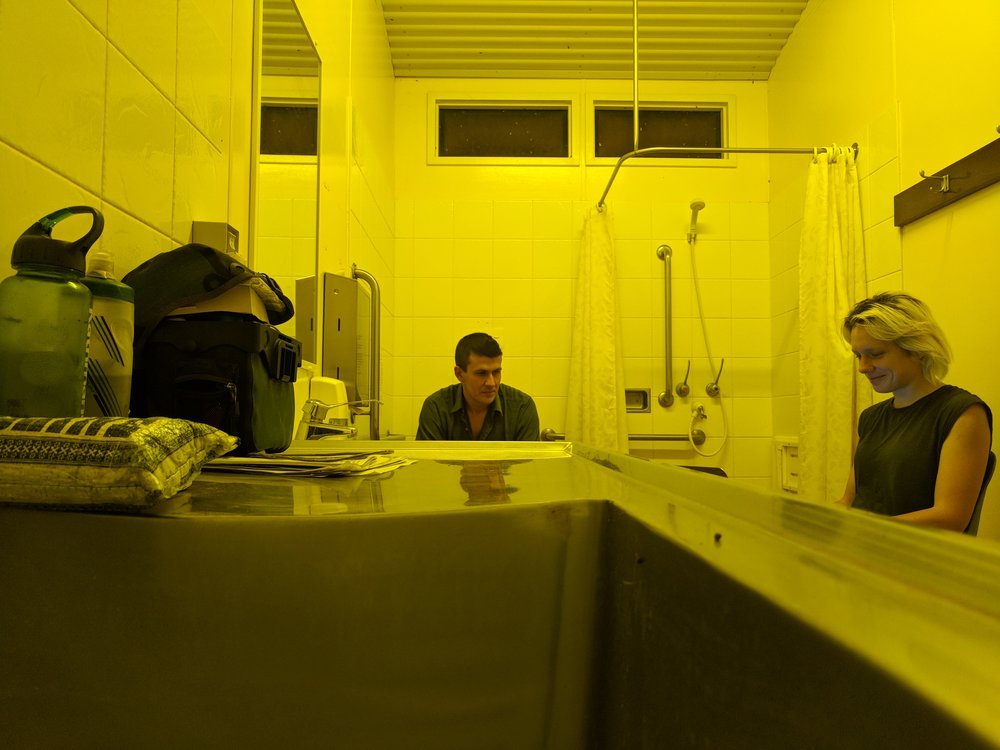
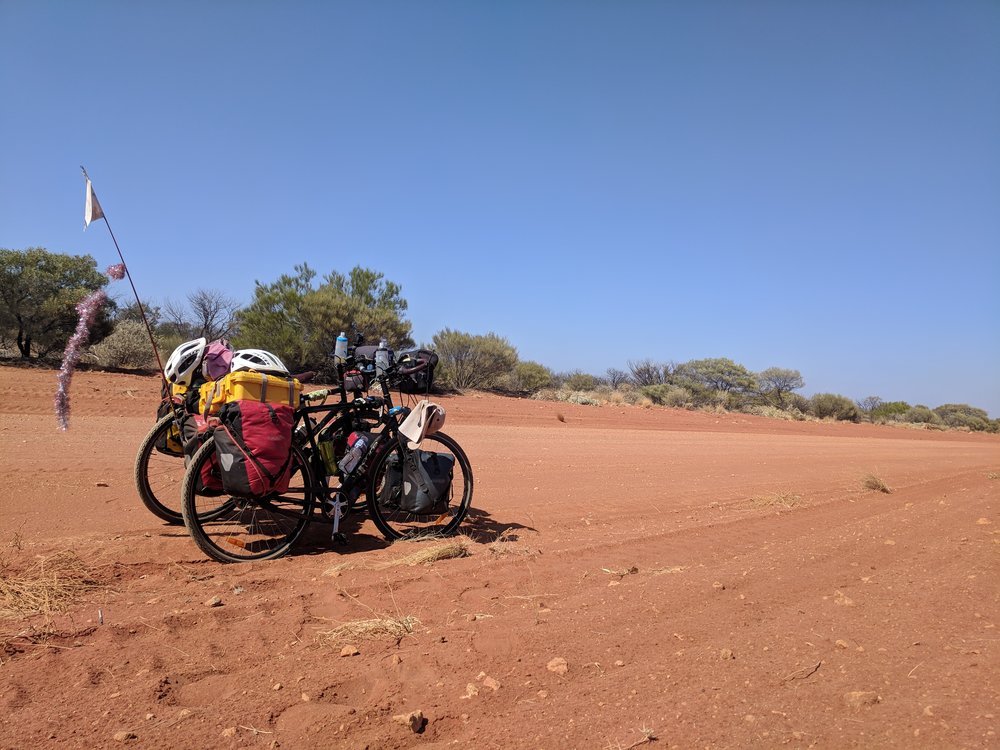
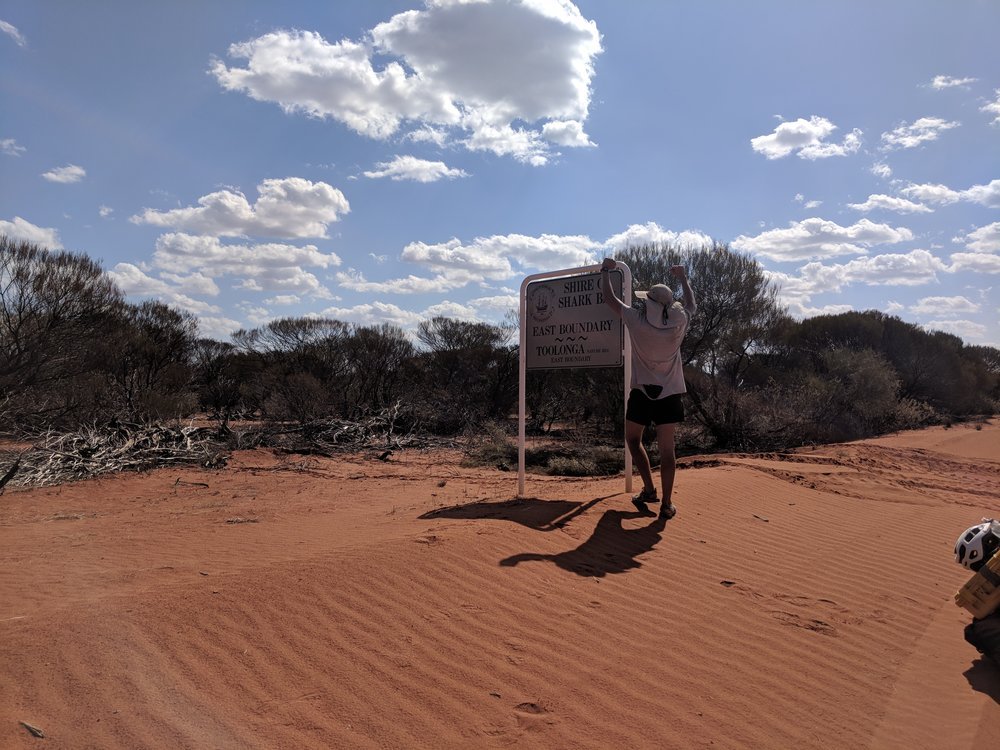

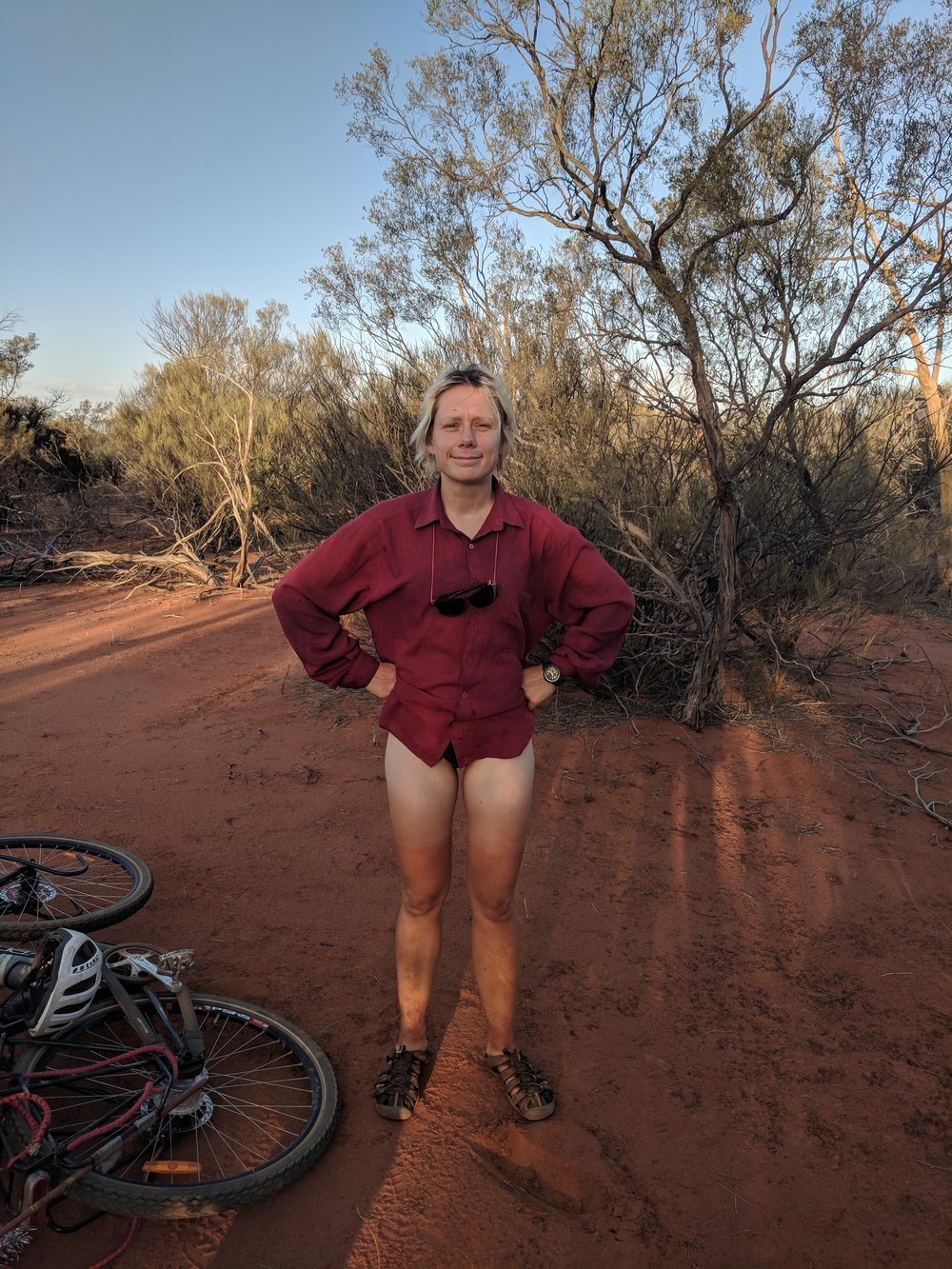
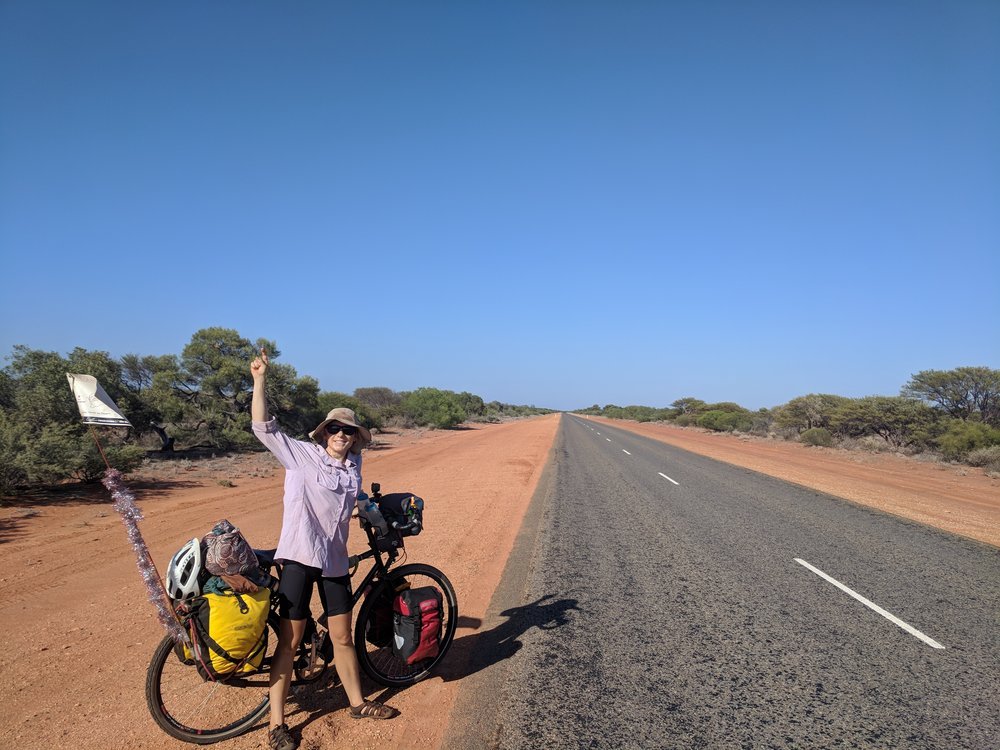
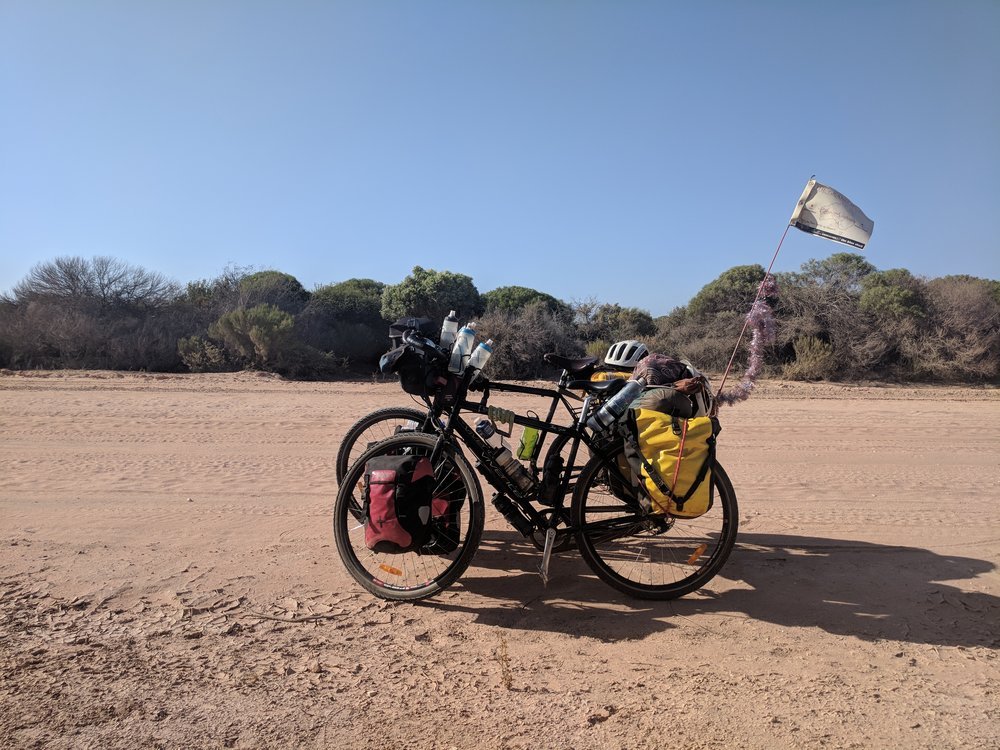
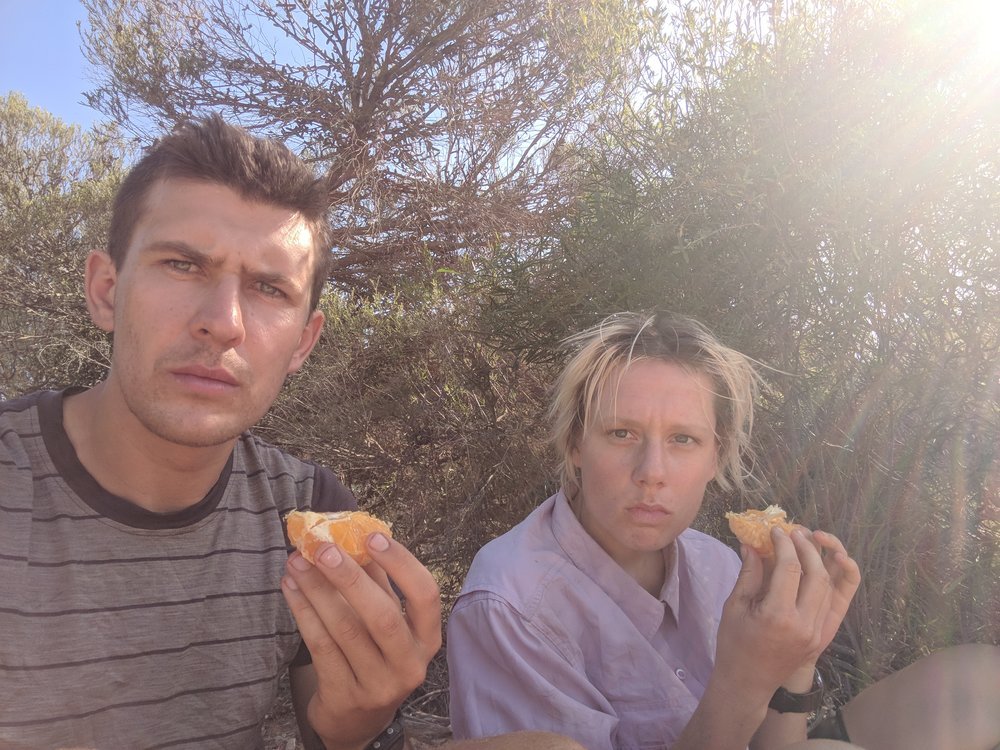
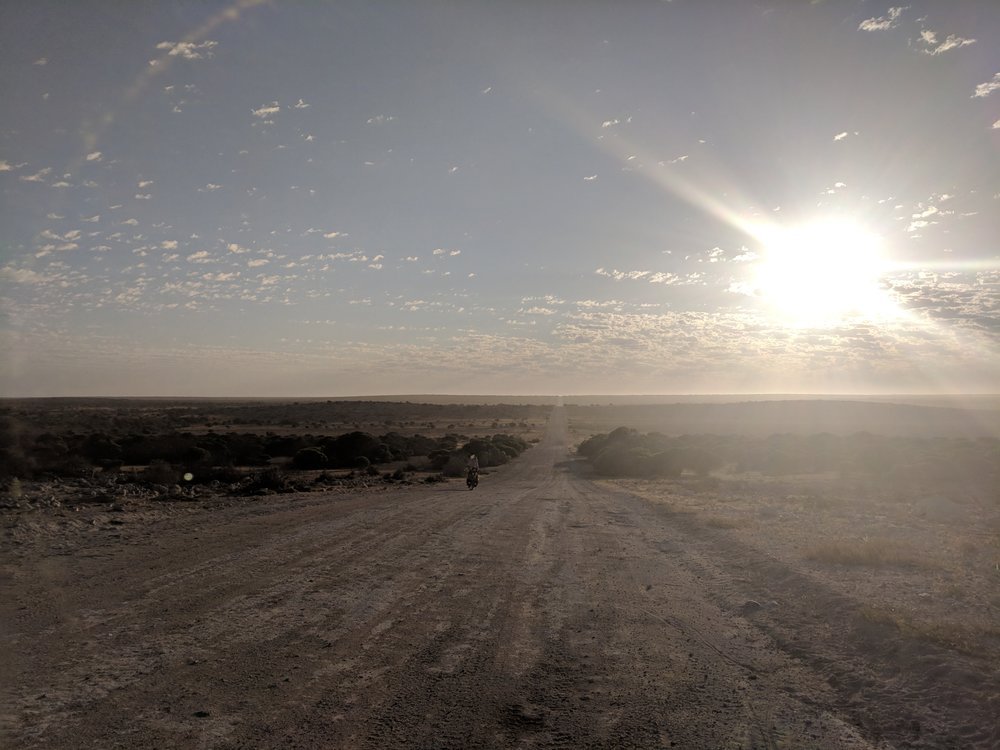
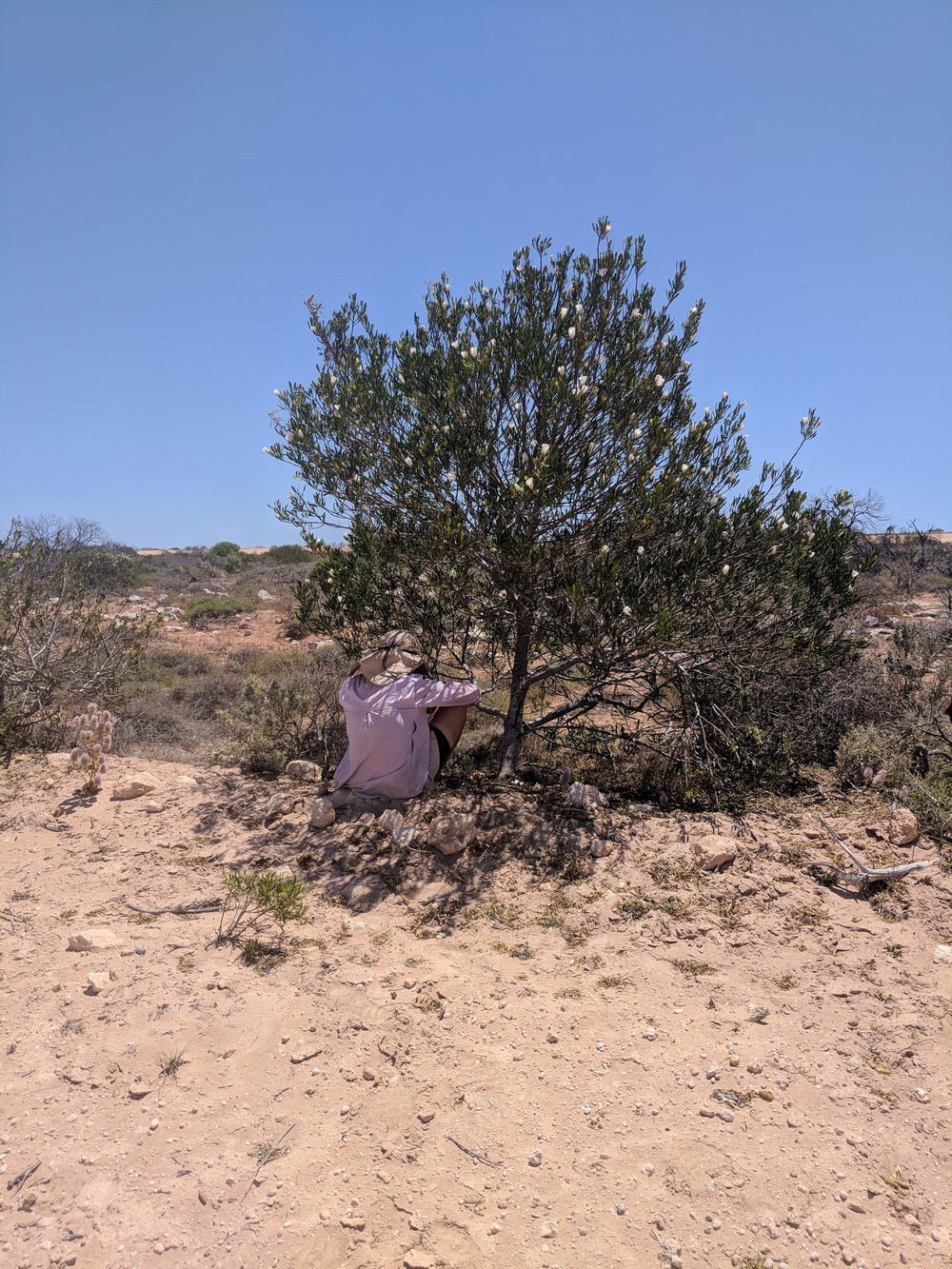
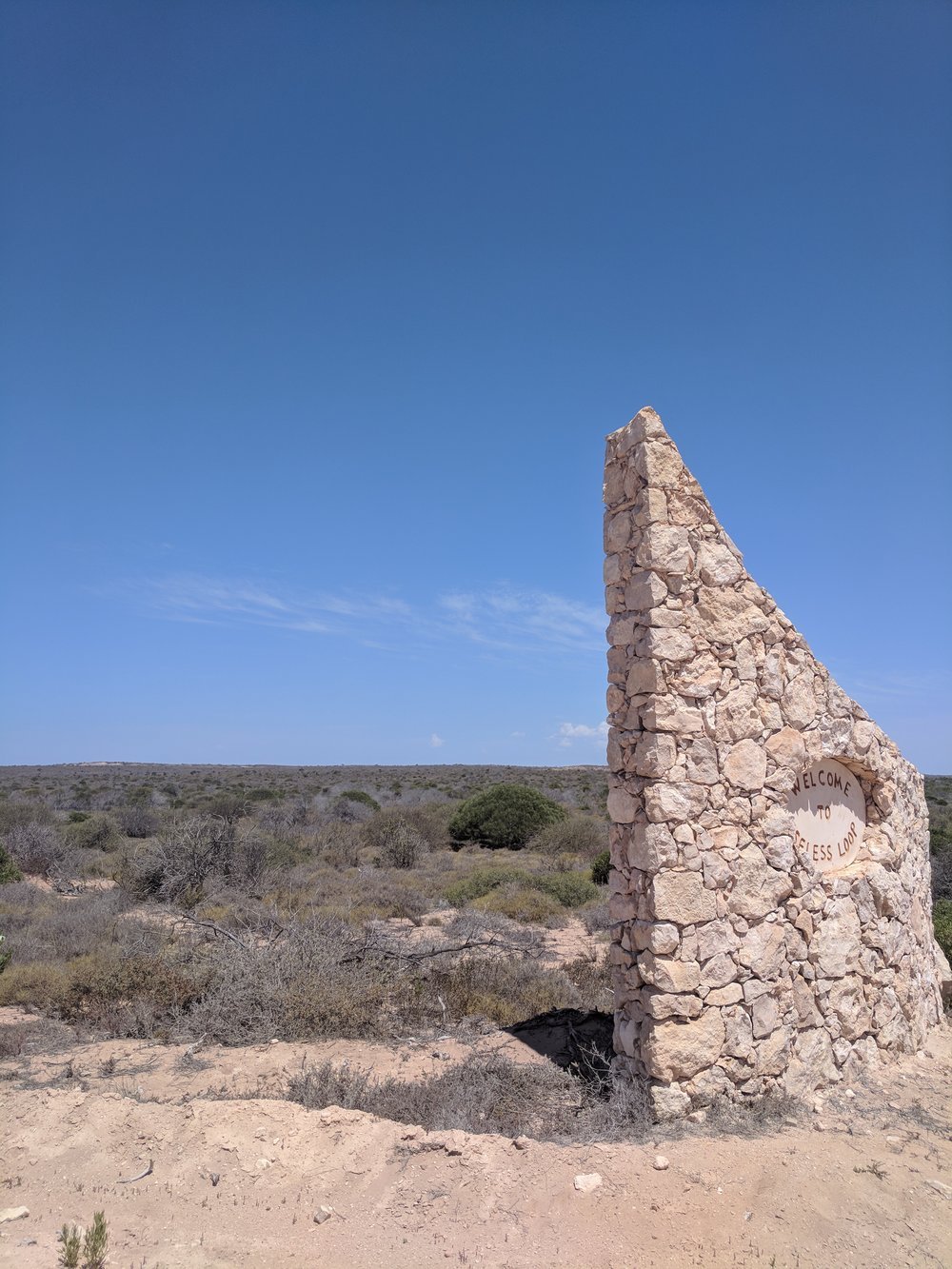

[i] https://audit.wa.gov.au/reports-and-publications/reports/management-pastoral-lands-western-australia/auditor-generals-overview/
Edited by the lovely Jen Richards
P.S; Who is she!? On that horrid stretch out of Fraser Island back at the start in February, two incredible people Kaz & Dave were waiting for the Wanggoolba Ferry as well. They gave us chairs, cold water, snacks and good conversation over the three hours and it turned out they too were from Singleton (Bobbie’s home town)!!
That evening, making it over to Hervey Bay we received a lovely email from Jen, who is the mother of Dave from the ferry. She gave us great encouragement and picked up some spelling errors in our very first blog, of course considering she is a retired Business teacher. Jen sadly had to retire due to a stroke in 2011 but has a passion for learning about Australian history and so, much to our luck offered herself as our blog editor to keep her brain as active as possible in an attempt to combat her high risk of suffering dementia following her brain damage. We write our blogs when we’re back in reception, send them off to Jen and within a quick turnaround she has them back to us, edited. We send through research requests at times for our next stops and she delivers the goods tenfold. An amazing woman and we are so grateful for her contribution to The Grand Section. Thanks Jen, you’re a bloody legend!
Over the 4 days we would rest often as the heat and hot wind was draining. Sapping energy from us quickly and furiously, we rode early waking up at 3am to get the hours in before sunrise. Sunrise at 5.30, by 7am sweltering sun beams burnt the skin. The landscape isn’t forgiving and the life-source (water) hard to come by. Many windmills and tanks empty, broken and brittle under the intense sun. Day 03 We found a working windmill powered bore, we were incredibly grateful for water cooler than our 35deg water. That stuff just doesn’t quench the thirst.
As usual, a headwind on our final day into Wooleen Station made us fight to earn an arrival. Fatigue had started to set in by that point. Overall exhaustion to be honest from the past 8 months of riding and momentum. To keep going it got to the point of counting down kilometers one by one, celebrating the reaching of each one. Counting the 385 reptile tracks we cut through on the dirt track gave some distraction, but also strong feelings of wariness.
The oasis, Wooleen arrived at the end of a red dirt track. Tall Palm and gum trees as usual, the mark of civilisation eased our worries and strain. We startled Frances, the owner wandering across the lush green lawn moving sprinklers – “oh! You’re early...” followed by a warm, hospitable and welcoming laugh. She gave us a beer each, we sat with the dogs and drank.
Edited by the incredible Jen Richards, we hope you are feeling better!
[i] http://austhrutime.com/mulga-woodlands.htm
[ii] https://www.environment.gov.au/system/files/resources/a8015c25-4aa2-4833-ad9c-e98d09e2ab52/files/bioregion-murchison.pdf
[iii] https://daciangold.com.au/company-profile/
[iv] Article: FIFO work can increase risk of mental health issues, WA parliamentary committee finds - mobile.abc.net.au
[v] Gunyah, Goondie and Wurley, Paul Memmott, 2007

